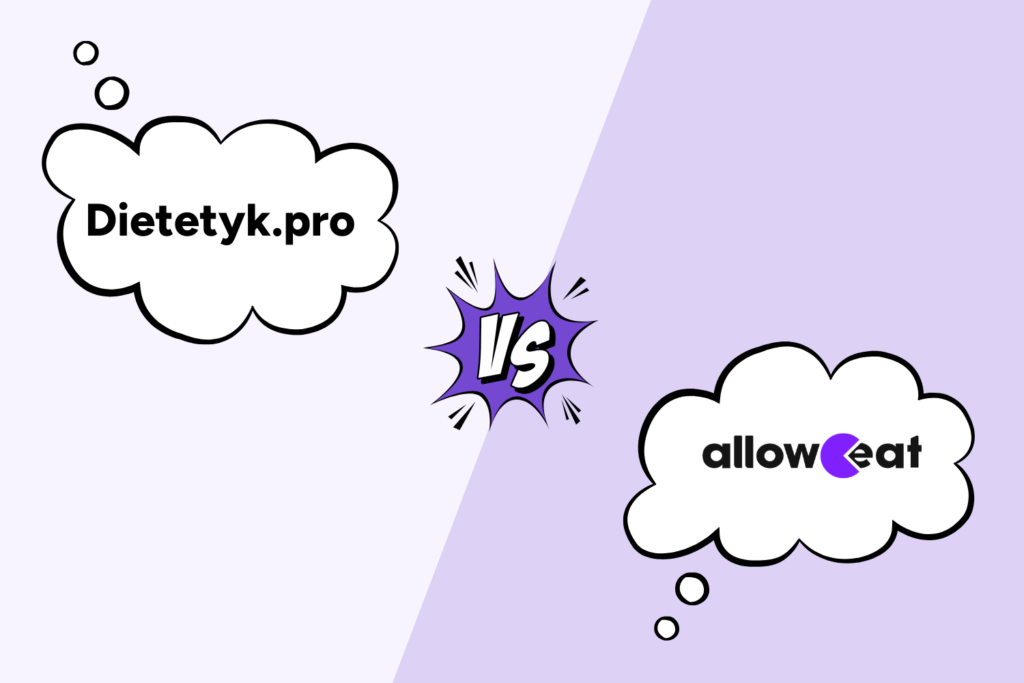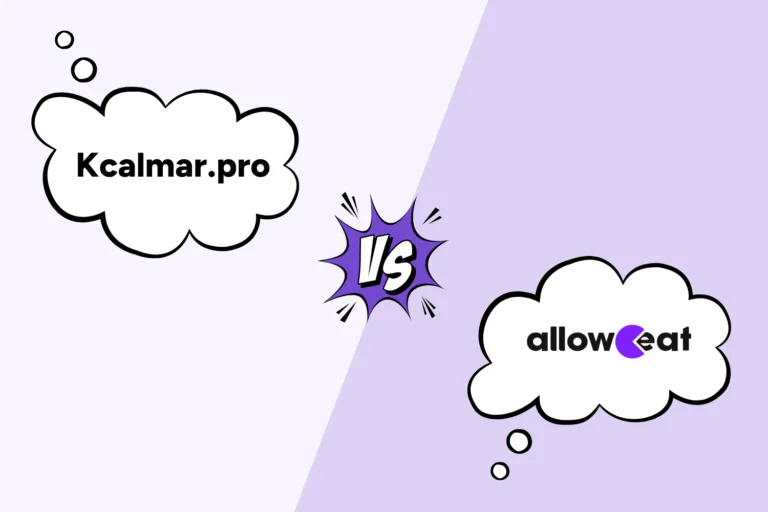Last updated: January 24, 2025
Welcome to another article in our series, where we compare the features and capabilities offered to dietitians by alloweat and other solutions available on the market.
You can read the other comparisons here:
The idea behind these comparisons is to provide you with reliable, side-by-side information – so you can choose tool that best fits your needs and expectations.
What are we comparing?
In this article, we are comparing alloweat with trial version of Dietetyk.pro, which provides free access to all features for 7 days. With alloweat, you also get full access without limitations, but trial period lasts 14 days.
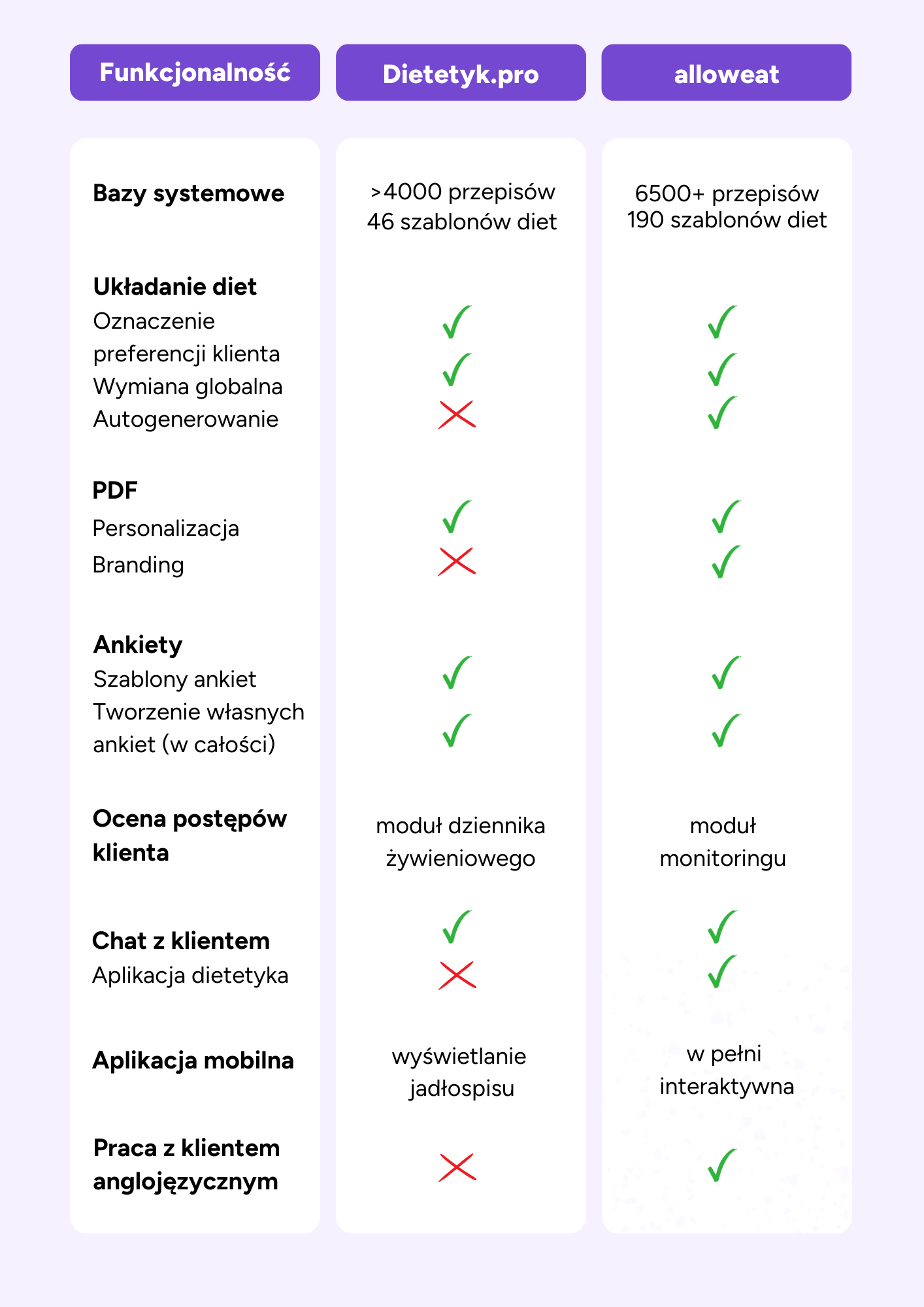
Comparison scope
Meal planning
For many professionals, writing diets is still an integral part of daily work. So let’s take a closer look at how Dietetyk.pro and alloweat support users in optimizing this process.
System databases
Well-organized, extensive databases with advanced filtering options are essential for quick and efficient meal planning, especially when working with more complex clinical cases.
On the Dietetyk.pro website, you will find information about database containing 9,500 products and recipes, sourced from the official Polish IŻŻ database and the American USDA database. In addition, there are 46 diet templates available to help speed up your workflow. Each database can be customized and any manually added products or recipes can be saved as “favorites”.
When creating or searching for recipes in database, you can use tags grouped into several categories:
- meal type
- kitchen equipment
- preparation time
- difficulty level
- number of servings
- tags describing meal characteristics, e.g., gluten-free, egg-free, vegetarian or types of meals like desserts or smoothies
Beyond the built-in tags, users can also create custom tags. When created thoughtfully, these can help maintain structure and clarity in your personal database.
Additionally, you can attach images to recipes (system recipes also come with photos), which enhances visual presentation and improves the overall user experience.
When discussing databases, it is worth noting that Dietetyk.pro also includes a set of ready-made recommendations for various health conditions. Users can create their own recommendations quite intuitively as well. However, the recommendation editor has limited formatting options – you can only add title, body text and basic table with fixed system layout.
For example, if you want to create table with more columns, highlight parts of the text in color or add bullet points to improve readability, these features are not available.
ALLOWEAT
Product and recipe databases in alloweat are built using three main data sources:
- USDA FoodData Central (USA)
- McCance and Widdowson’s Composition of Foods Integrated Dataset (UK)
- Australian Food Composition Database (AUS)
Whole database includes over 10,000 products and 6,500 recipes.
Product and recipe databases can be filtered using thoughtfully categorized tags. For example, the recipe database includes over 100 filters, grouped into three key categories:
- meal preparation
- nutritional values
- other relevant recipe characteristics
What is more, alloweat also includes collection of 137 nutrition programs, each designed for different client profiles. These programs contain not only fully tailored meal plans for specific conditions but also matching educational materials and detailed recommendations.
In addition, alloweat provides access to 190 built-in diet plans and 690 recipe collections (collection is a group of recipes with shared characteristics for instance, set of 20 lunch recipes balanced to 600 kcal, with 25–30 g of protein, all vegetarian).
System recipe (and collection) database, similar to Dietetyk.pro, has been enriched with meal photos. You can also add them when entering your own recipes.
Platform features dedicated section for creating client recommendations. There are also ready-made system templates available, either for immediate use or further editing. The recommendation editor allows you to insert images or graphics, style the text and create fully customized tables.
WHAT IS THE DIFFERENCE?
While both platforms may seem similar at first glance, a closer look reveals that alloweat’s databases are more extensive and its tagging/filtering system significantly more advanced. In addition, alloweat provides more versatile recommendation tools, allowing you to create client education materials with greater ease and customization.
Diet planning process
If working with a client requires you to prepare detailed meal plan, it is worth ensuring the process is both efficient and accurate. Using tools that streamline repetitive tasks can greatly reduce time spent on them – freeing up space for client education or more frequent communication.
DIETETYK.PRO
In Dietetyk.pro, meal plans are created using weekly calendar view (you can also switch to daily view). You can build a plan for any chosen number of days.
When adding meals to the weekly calendar view, you can search using filters that match tags assigned to meals in the recipe database. Filtering by a specific ingredient is particularly helpful, especially if client has strong taste preferences. Once meal is selected, it can be edited and personalized with a note visible to the client.
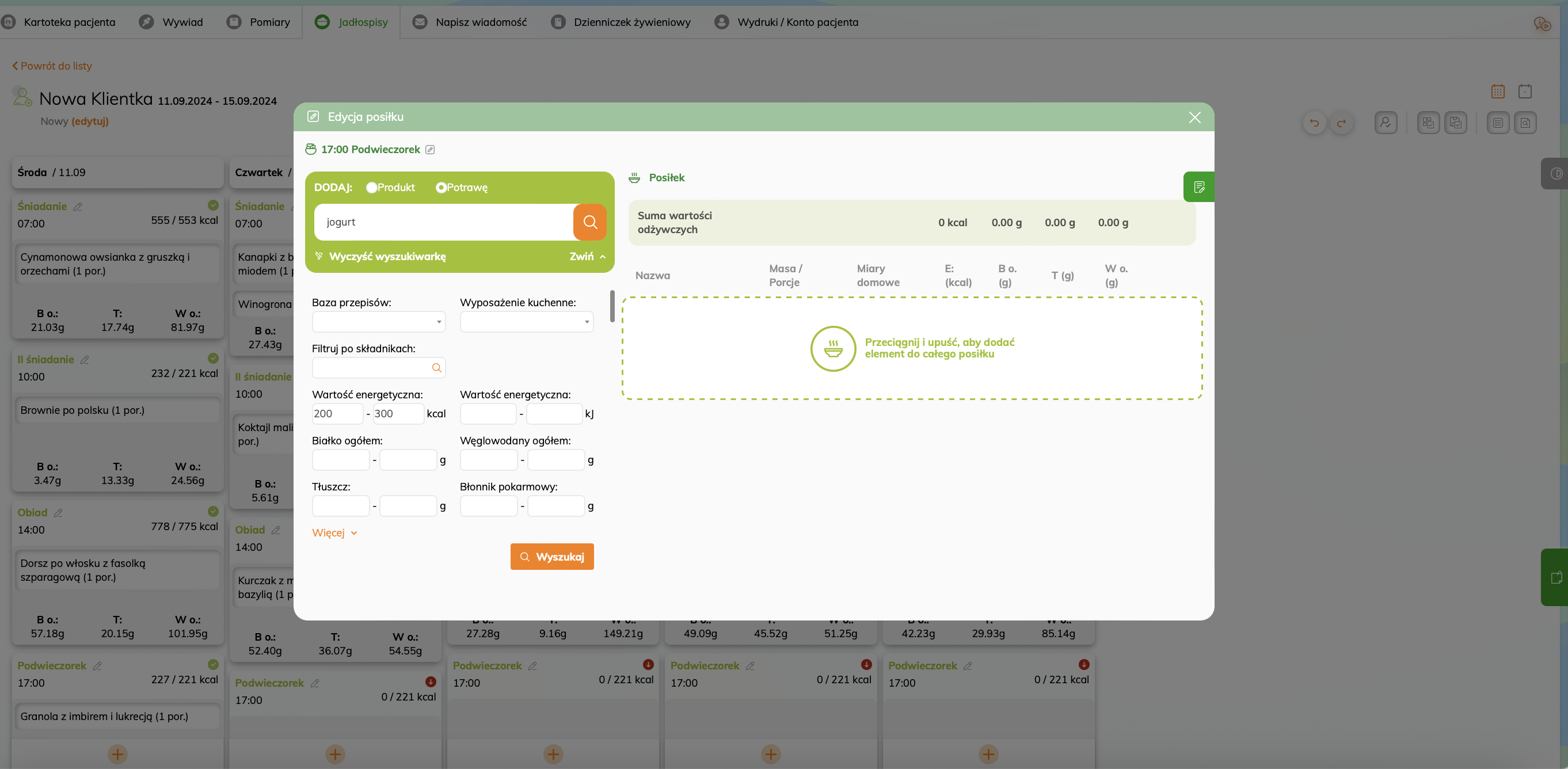
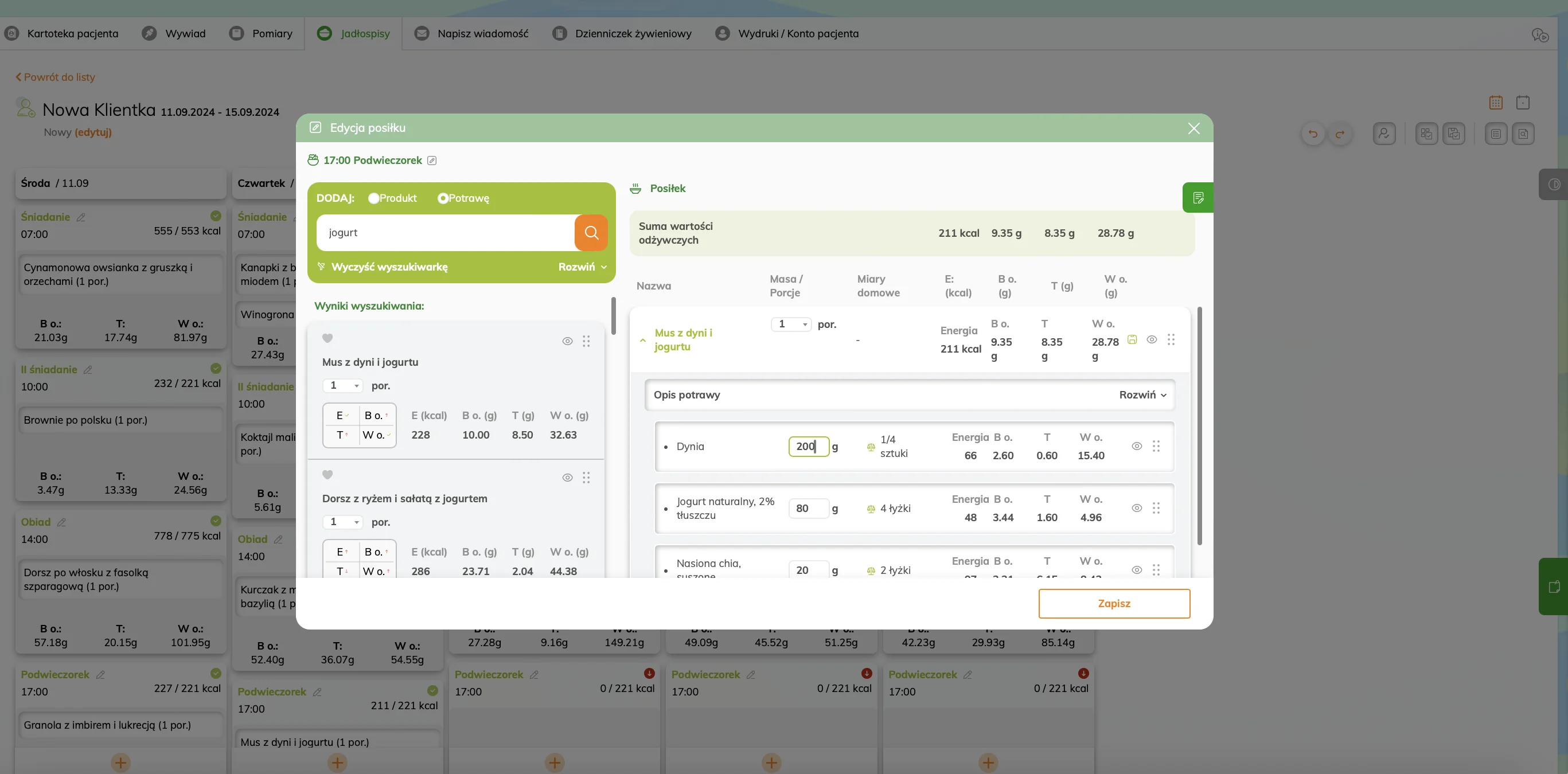
When searching the recipe database, system also suggests meals based on a dedicated algorithm. These suggestions take into account meal’s popularity, seasonality and ingredients used. It is a useful source of inspiration when building a meal plan.
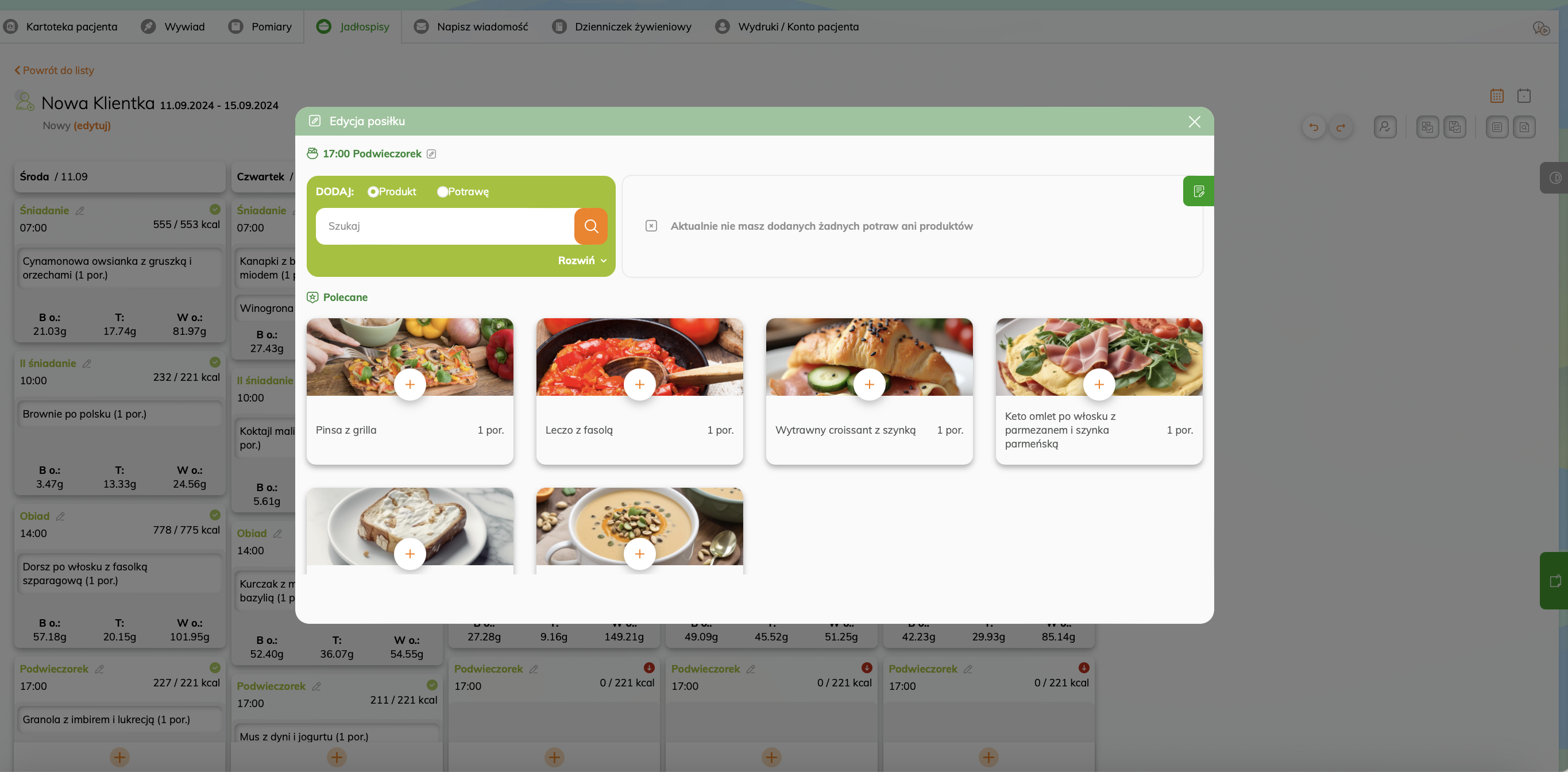
While working in the calendar view, several features are available to help tailor the plan to your client’s individual needs and preferences and to speed up your workflow. These tools can be accessed via collapsible side panel. They include:
- preview of foods that are not recommended for the client, including allergens (if specified by client in the survey or at client’s profile)
- option to check whether any of the meals in the current plan have already been used in previous ones
- list of unused ingredients, which can be dragged directly into the calendar to help minimize food waste
- clipboard function to temporarily store meals you may want to use in another week
- global product replacement feature, making it easier to standardize ingredients across the meal plan
Another helpful function is the ability to undo and redo multiple actions while working on the plan, so if you make a mistake, it is easy to return to the previous step.
You can also account for your client’s physical activity on a specific day by selecting it from a system list. Calories burned will then be automatically included in the client’s daily energy balance.
Once the meal plan is complete, you can attach a set of recommendations, either using built-in templates or your own, previously created suggestions from database.
ALLOWEAT
Alloweat introduces modern approach to working with clients. With this solution, you can create personalized nutrition programs that include either traditional meal plans or general dietary frameworks (based on calorie content and macronutrient distribution). Whether or not you want to use meal plan in your client work, each nutrition program can be enriched with educational materials, recommendations or supplement plan—organized into separate, easy-to-navigate sections.
Nutrition program can cover any number of days.
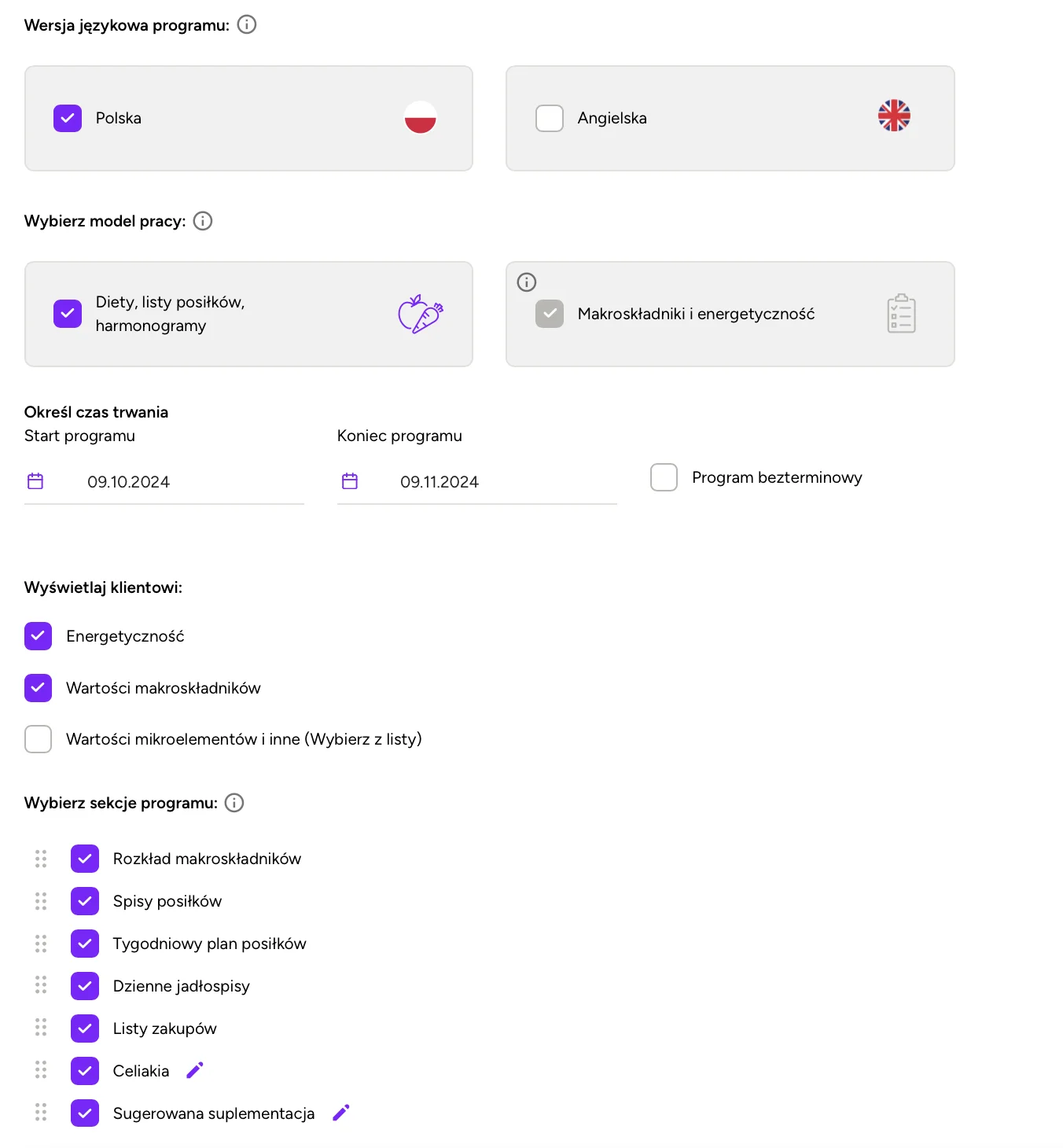
If you choose to include meal plan, alloweat makes the process fast and efficient. In just a few minutes, you can use the auto-generation feature to quickly generate 20 recipe suggestions per meal. Meal plan can then be freely adjusted to suit your client’s needs, including their dietary preferences (such as allergens, liked or disliked foods).
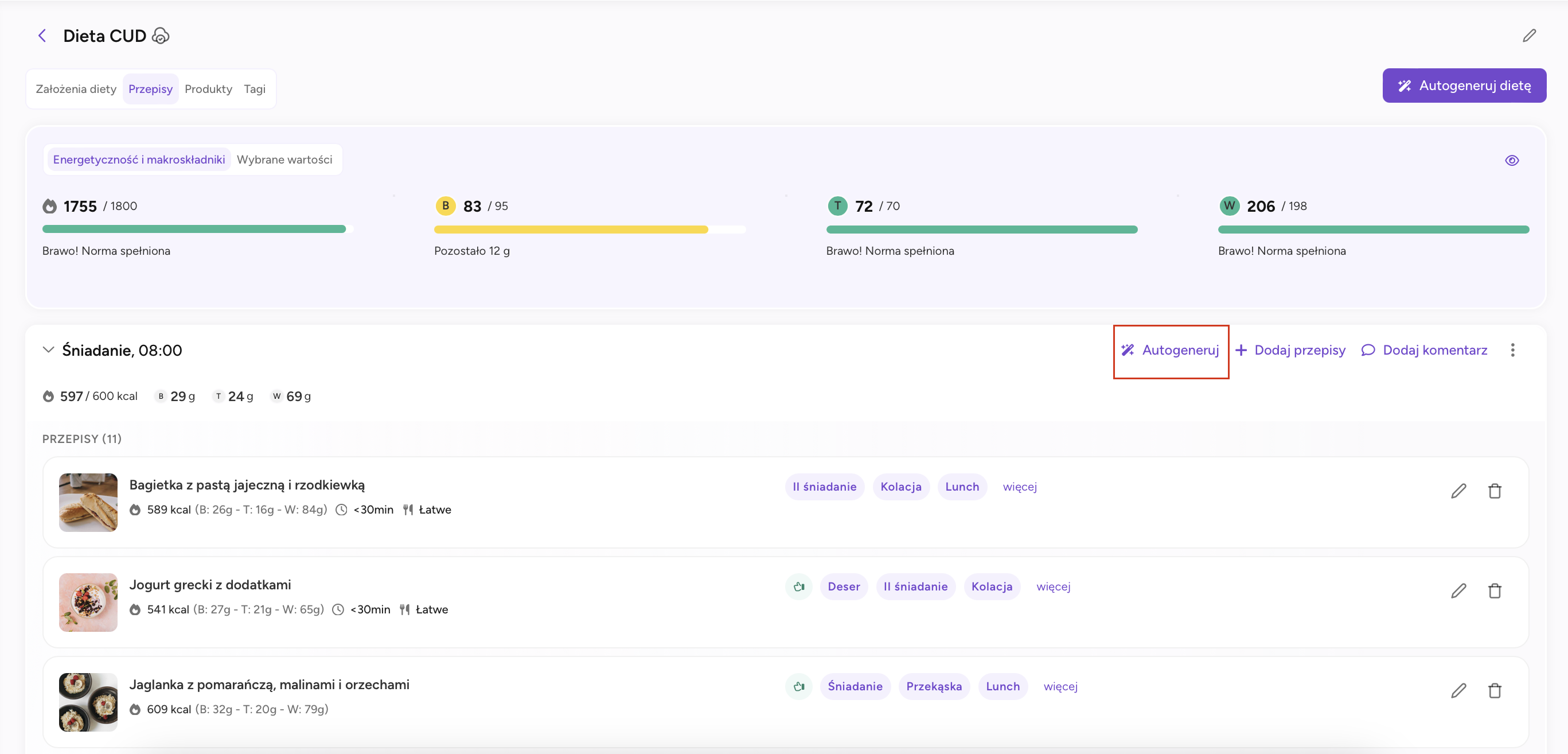
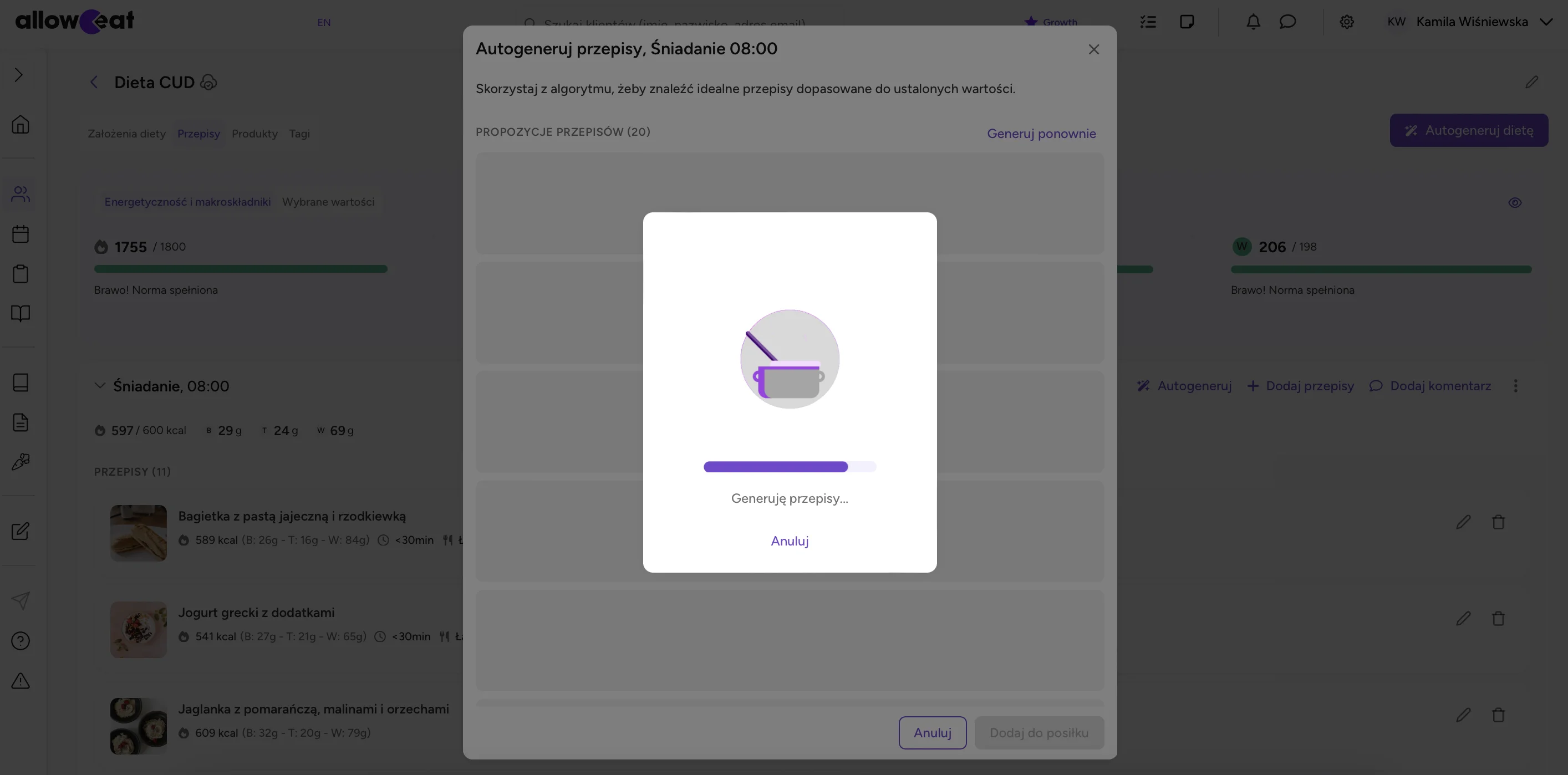
Even without using the auto-generation tool, alloweat offers variety of features to automate your work. For example, you can build a plan using full recipe collections (like a set of 15 vegetarian lunches balanced at 500 kcal) or combine individual recipes from different collections.
When creating diet within a nutrition program, you can quickly find the recipe or collection you are looking for using filters based on over 100 available tags (as discussed in the “System databases” section). These filters also take your client’s preferences into account – if client has food allergies or intolerances listed in their intake form, recipes containing those ingredients will be flagged.
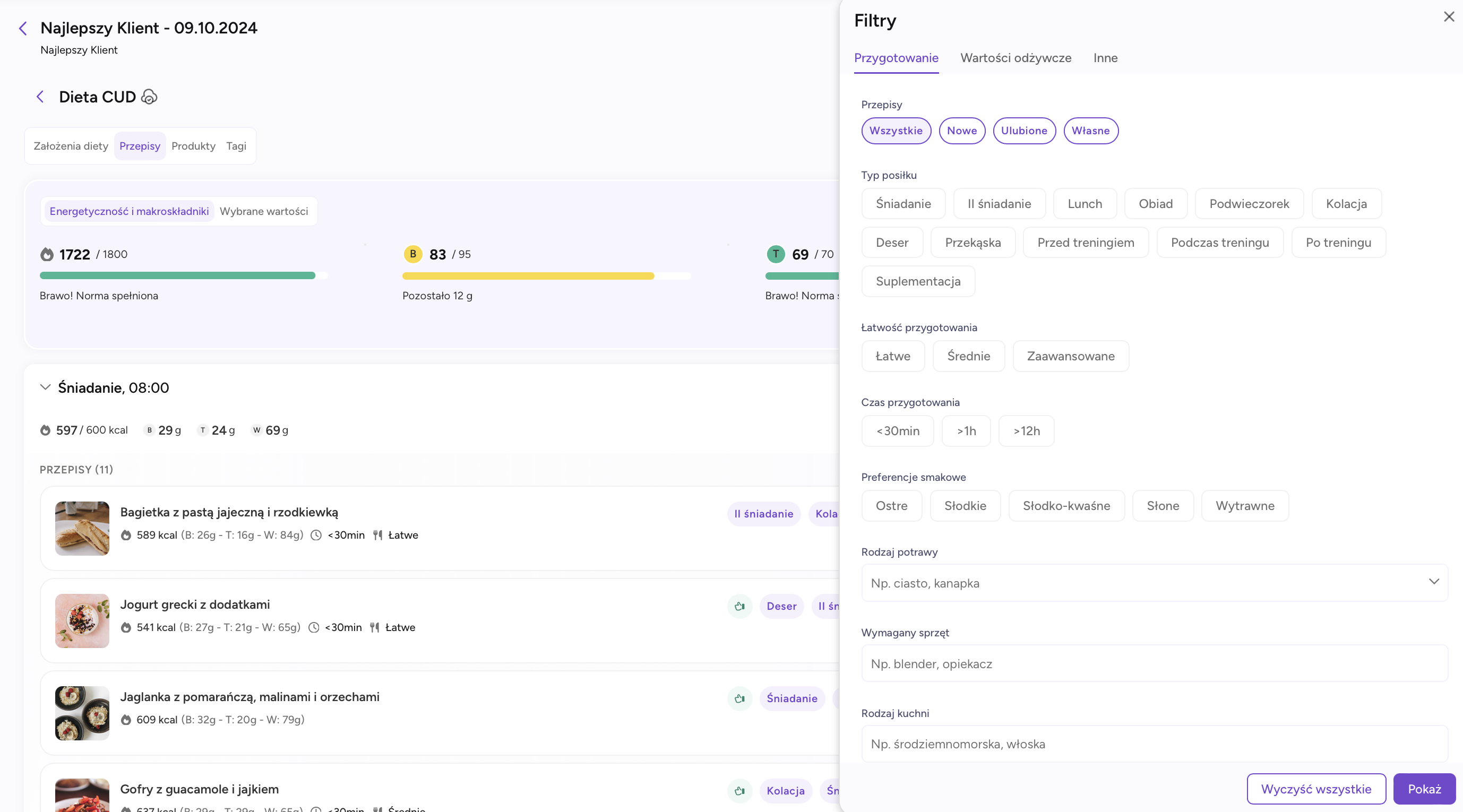
Global replacement module allows you to standardize ingredients across the entire meal plan and easily modify recipes – all from convenient side panel.
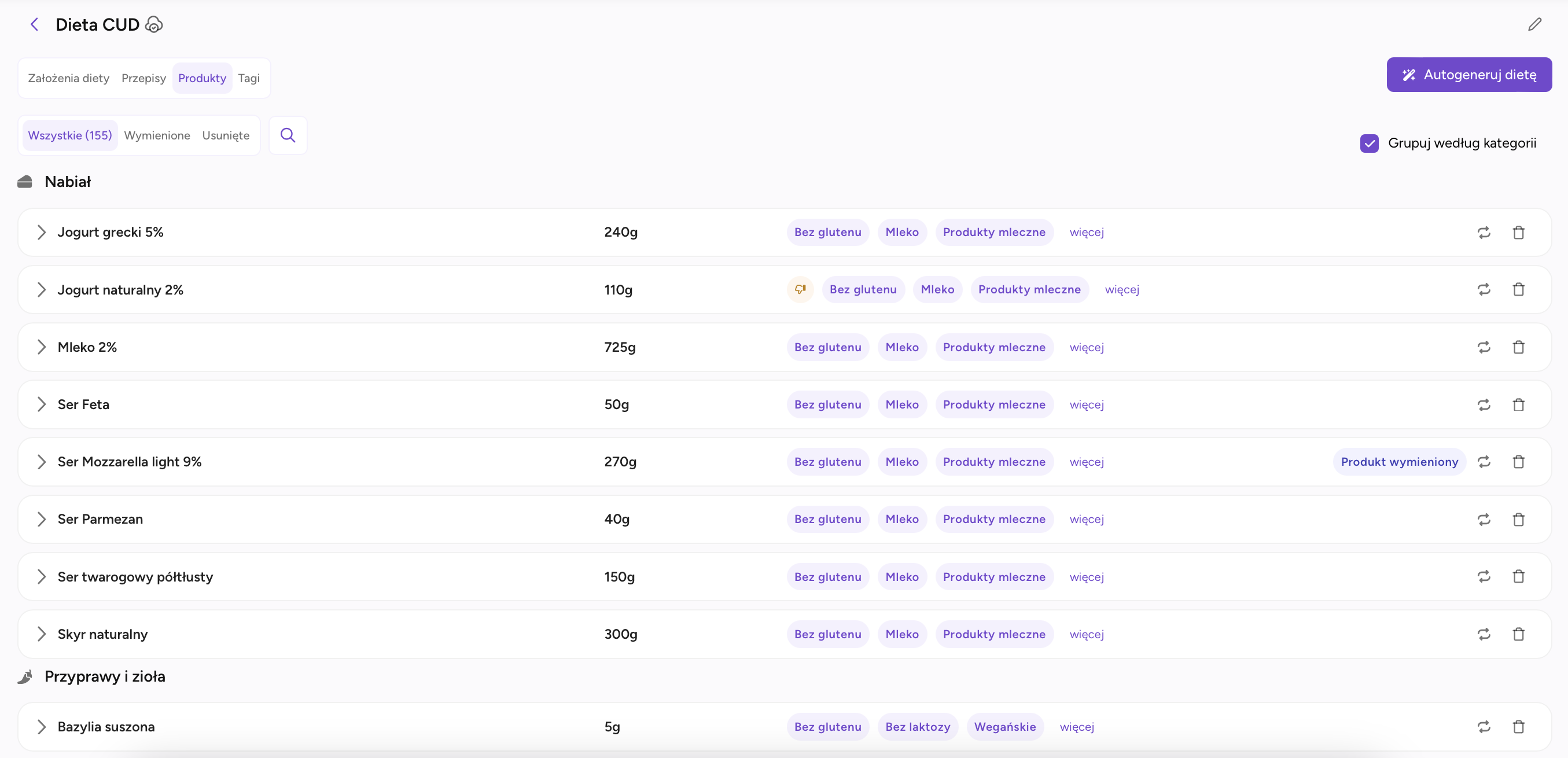
Once you have selected recipes for specific meals, you move on to the schedule view, which looks similar to the calendar view in Dietetyk.pro, with one major difference: alloweat’s smart algorithm helps generate full daily menus based on your defined criteria. This significantly speeds up your workflow, ensuring your dietary goals are met without needing to balance everything manually. You can also auto-generate daily meal plans for a specific client using any diet template from database, making the whole process much faster and more efficient.
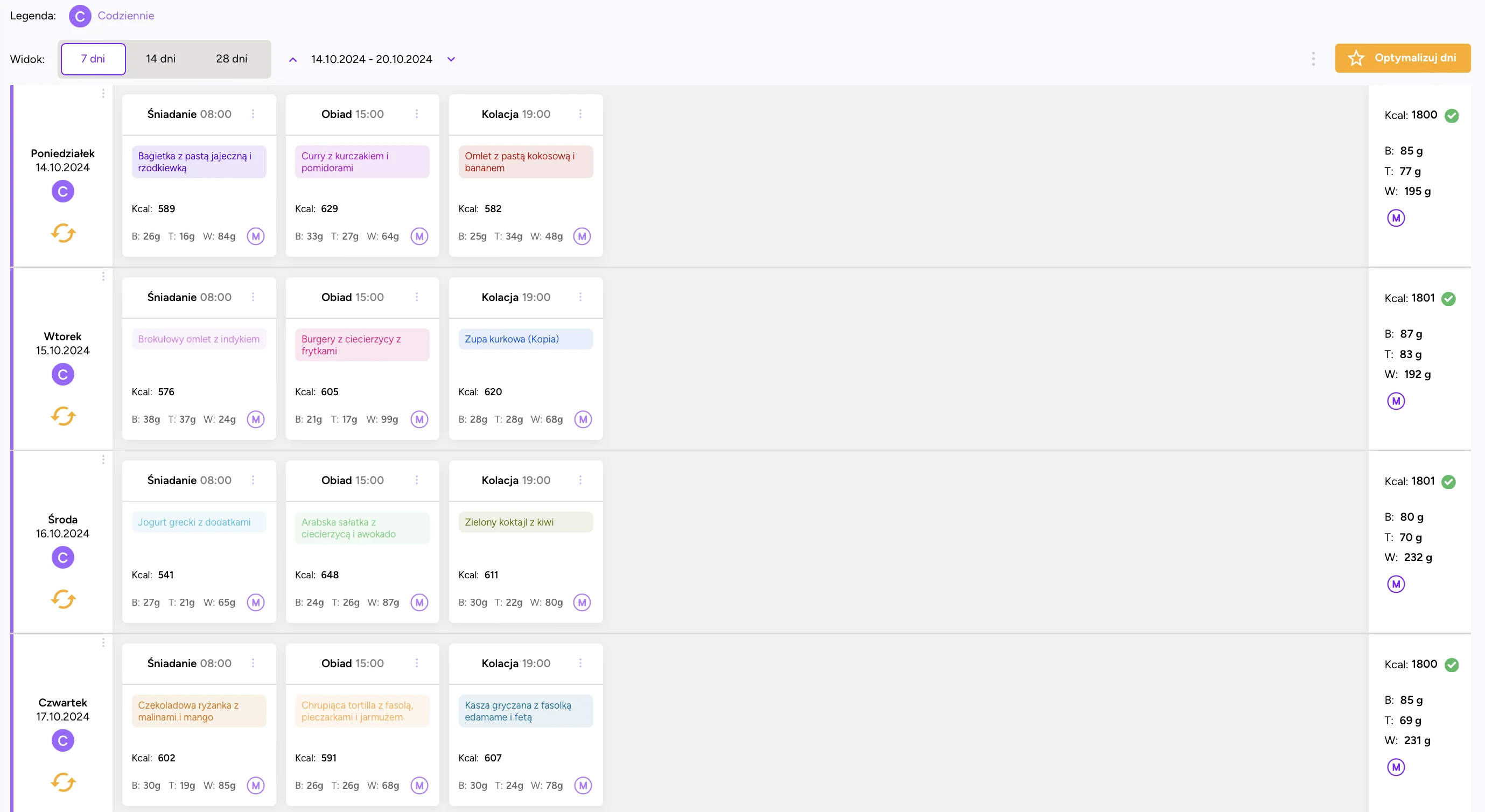

It is also worth noting that each nutrition program can include multiple meal plans, which is especially useful for sports dietitians creating rotational meal plans that reflect different training intensities across the week.
WHAT IS THE DIFFERENCE?
If you prefer more flexible approach, are open to using modern tools and work methods and want to save time – alloweat is likely better fit for you. It is the right choice if you do not measure your work’s value solely by handing over meal plans and instead want the freedom to decide how you work with each client. And when cooperation will require detailed meal plan, alloweat lets you automate that process, minimizing your manual effort. Instead of spending hours hand-picking meals, you can invest that time in what truly matters: your clients.
PDFs remain one of the most common ways to deliver nutrition plans and recommendations to clients. When designed well, they not only help clients understand and implement changes but also play a key role in building professional image for the dietitian. The ability to personalize PDFs allows you to better adapt the content to each client’s needs and to your own style of work.
DIETETYK.PRO
When generating a PDF, you have plenty of configuration options, such as:
- choosing cover layout (or uploading your own)
- deciding which elements to display (e.g. recipe photos or calorie content)
- selecting which nutrients to show (limited to 3 in the PDF)
- defining time range for the shopping list
- setting type and order of sections (fridge printout, meal plan, shopping lists)
- customizing font size and color
Once configured, PDF can be downloaded and shared with your client via their online account or mobile app.
ALLOWEAT
In alloweat, PDFs can be personalized both visually and in terms of information included. There are three built-in templates to choose from: print-friendly minimalist version (without recipe photos) or more stylish versions with covers that include photos or illustrations.
You can also choose primary color for the document and when using photo cover, you can select from 20 built-in image suggestions. Users on the highest subscription plan have access to full brand customizatio, this includes adding their own logo, removing the alloweat branding, matching document colors to their brand and uploading custom cover photo.
You can include a “fridge printout” in PDF and even lengthy documents are easy to navigate thanks to the interactive table of contents.
You can also define which elements are visible to the client in PDF, such as the day of the week, date or mealtime.
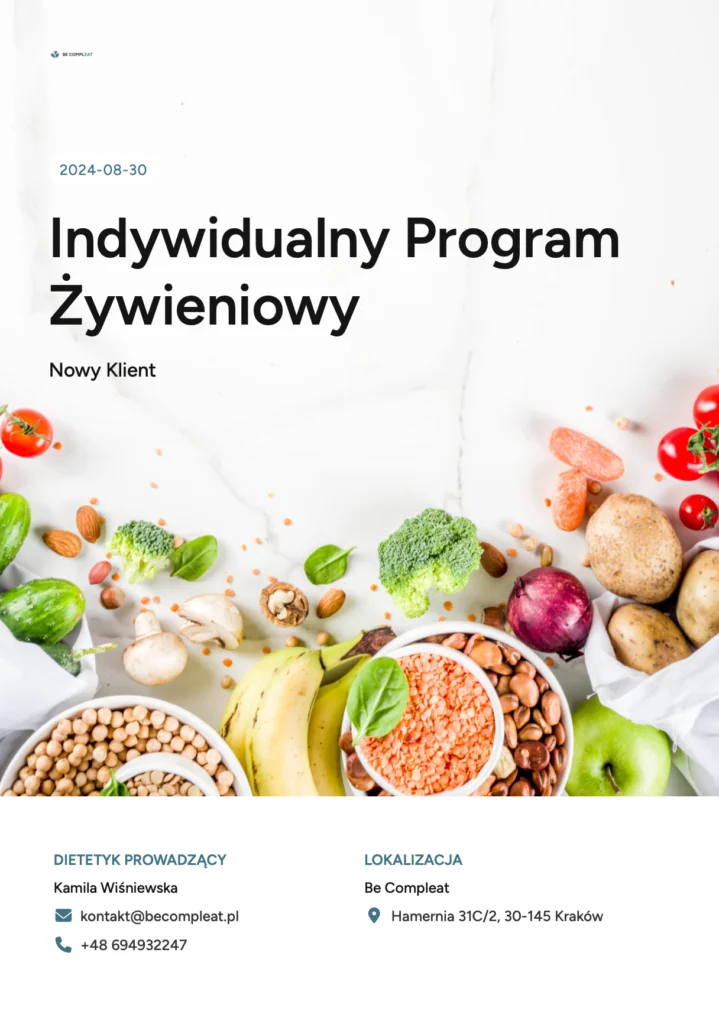
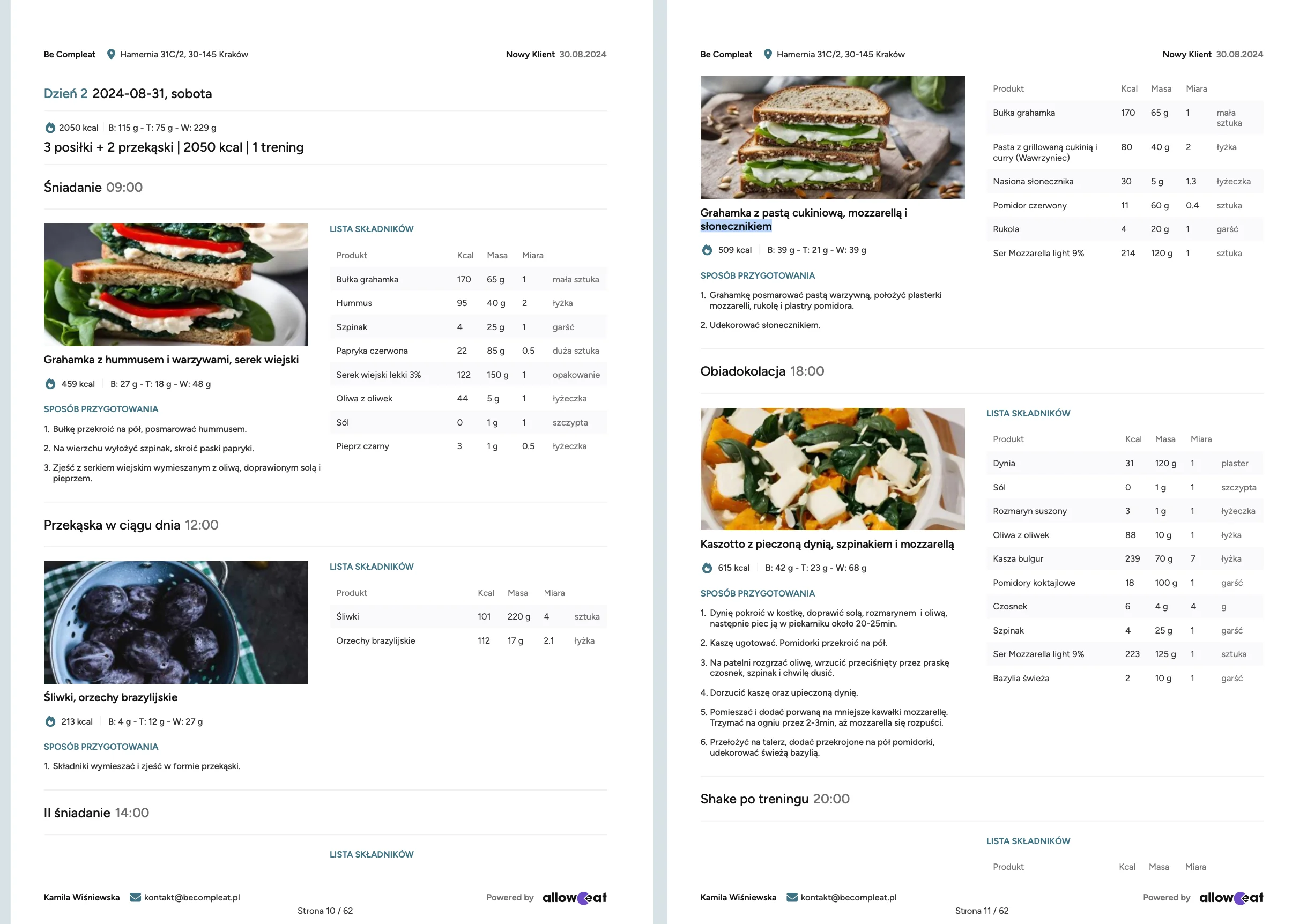
Nutrition programs can be shared directly via email from platform or made available in client’s mobile app.
WHAT IS THE DIFFERENCE?
While Dietetyk.pro offers slightly more options for sharing meal plan, client can only view it (via their online account or app), with no option to make changes. In contrast, alloweat mobile app was designed to engage clients more actively in the process. Clients can edit shared plan, swap out or modify recipes provided by dietitian or add their own.
So, if you want to give your clients more autonomy and turn your plan into practical tool for habit change, alloweat’s mobile app gives you that power.
Client cooperation
Managing client relationships is core part of dietitian’s work. It includes not just building personalized nutrition plans but also handling appointments, staying in touch and tracking progress. Let’s take a look at how Dietetyk.pro and alloweat support these tasks.
Appointment scheduling
To begin working together, client first needs to schedule an appointment. Integration with an external calendar tool, allowing clients to book, reschedule or cancel, can prevent scheduling mishaps and reduce manual admin work for specialist.
DIETETYK.PRO
Dietetyk.pro integrates with the DietDoctor calendar system, platform where clients can search for dietitian based on specialization and book appointments. All you need to do is create a profile, list your services, availability and office locations (including online consultations if applicable). Clients can then book sessions independently. Scheduling widget can also be embedded into your website, increasing your visibility and making it easier for clients to book at their convenience.
Clients can also manage appointments directly via mobile app.
Unfortunately, during trial version, it was not possible to thoroughly evaluate how this external integration works. Information presented here is based on details from dietetykpro.pl and tutorial materials available on the platform.
ALLOWEAT
Alloweat includes built-in calendar that can be integrated with Google Calendar. This minimizes risk of mistakes when using multiple calendars and makes it easier to manage appointments from any device with access to Google Calendar.
In addition to client sessions, system calendar also lets you mark important events and tasks.
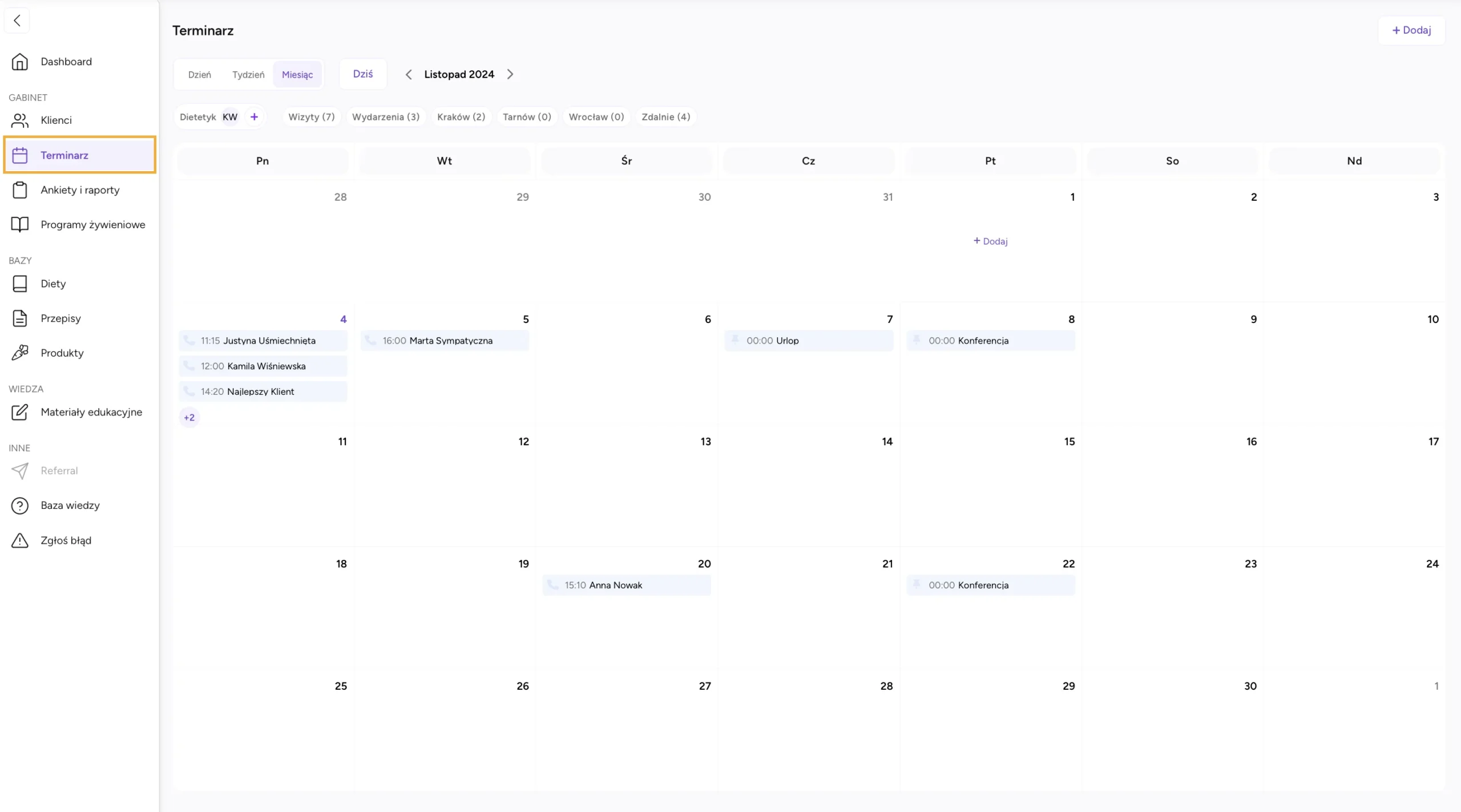
What is more, calendar and task manager are displayed directly on platform’s home screen, making it easy to stay organized at a glance.
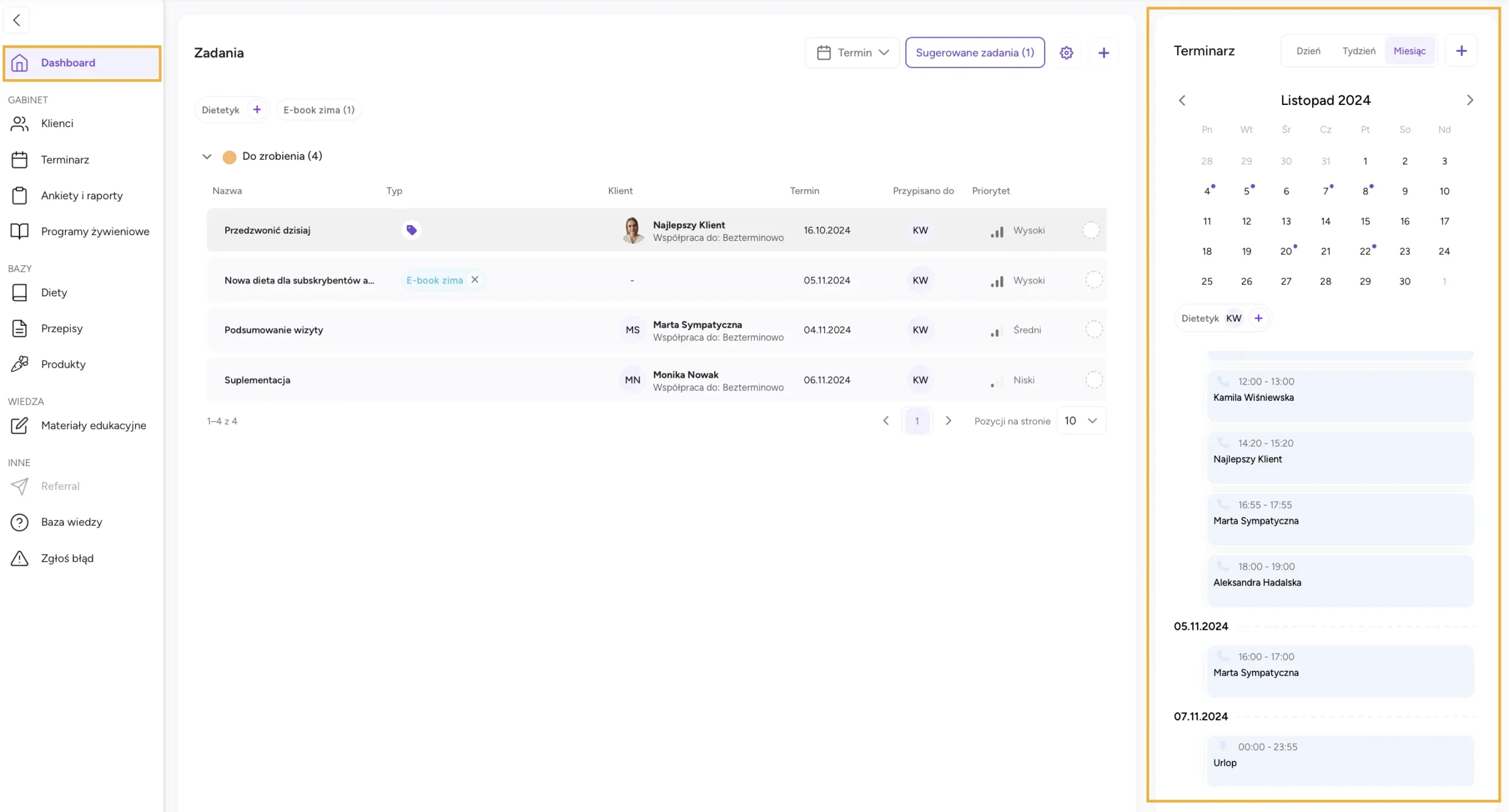
WHAT IS THE DIFFERENCE?
Both platforms offer different approaches to scheduling.
Alloweat gives you full control over appointment management through its built-in calendar, which can sync with Google Calendar. This helps you stay organized and plan your daily work more efficiently.
Dietetyk.pro, by integrating with external booking platform, enables automation of the appointment process.
Collecting client data
Accurate data collection plays crucial role in delivering effective dietetic support. The more detailed and precise information gathered, the better the entire process can be tailored to each client’s unique needs.
Creating surveys
Cooperation with client usually begins with filling out initial questionnaire. Well-designed survey provides comprehensive view of client’s situation, which is essential for planning next steps in the process.
DIETETYK.PRO
With Dietetyk.pro, you have access to three initial questionnaire templates that can be shared with your client via email or mobile app:
- basic nutrition assessment
- clinical nutrition assessment
- sports nutrition assessment
Each form can be duplicated and modified as needed. You can also build a fully custom questionnaire from scratch. System automatically includes core fields such as weight, height, birthdate, gender, physiological status and PAL (physical activity level) – which saves time, as these are essential in most cases.
Questionnaire creation tool works much like recommendation editor. You select types of questions you want to include and place them into the form, similar to assembling building blocks. Form is divided into five sections, which helps group related questions together and improves overall readability.
Some categories, such as allergies or chronic conditions, are suggested by default, but you are free to add your own custom questions. These can be set as open-ended, multiple-choice or rated on a 10-point scale.
You can also define which questions are mandatory.
Importantly, client responses related to disliked foods, intolerances and allergens are integrated with meal planning tool. This makes it easy to identify if any meals include flagged ingredients, allowing you to make adjustments accordingly.
Once questionnaire is ready, you can share it with your client via email. After it is completed, all responses automatically appear in client’s profile under the “Interview” tab. Based on body measurements provided, system calculates client’s BMI, ideal body weight, BMR and TDEE, giving you a solid starting point for building personalized meal plan.
If needed, information in the questionnaire can be edited manually at any time.
It is worth noting that if you decide to assign different questionnaire to the same client, previous responses will be lost, except for details related to allergies, intolerances and food preferences. This shows that form is designed to gather initial background information rather than serve as an ongoing record.
System does not send any notifications when client completes a questionnaire. You will only see it once you open their profile, along with the date it was submitted.
ALLOWEAT
Alloweat includes powerful and flexible form builder module (also used for reports), complete with editable system templates to help you get started quickly.
You can also create your own custom forms using mix of system questions and your own.
When using built-in questions, such as height, weight or disliked foods, client’s responses are automatically added to their profile. Answers related to food preferences (like allergens, disliked or intolerated products) are directly integrated into meal planning tool. For example, if meal includes an ingredient client does not like, it will be clearly flagged. What is more, based on collected data, alloweat will suggest meals that best match client’s preferences.
When creating your own questions, you can choose answer format (short/long text, single or multiple choice, date picker or even a table) and decide whether each question is mandatory.
Beyond client questionnaires, this module can also be used to create follow-up reports, self-monitoring journals or feedback forms to gather insights about your cooperation.
Questionnaires and reports can be sent to clients by email with just one click. Once completed, system notifies you automatically and marks client profile with a tag: “Form received”, small but helpful feature that supports your workflow. You can also filter your client list using this tag to easily find the most recent responses.
Each form can be sent multiple times and you can access all past responses anytime via client’s activity history.
WHAT IS THE DIFFERENCE?
Alloweat gives you more flexibility when it comes to building and using tools throughout every stage of cooperation with client, not just at the beginning. System notifications about submitted questionnaires and reports help you stay on top of the process and manage your workflow more efficiently.
Consultation notes
Ability to take structured notes during client visits helps dietitians track progress over time, analyze data more easily and adjust strategies based on previous sessions.
DIETETYK.PRO
In Dietetyk.pro, you will find a tab in each client’s profile called “Patient file” where you can write general notes about the cooperation and attach files if needed. Files can be grouped into folders, but note-taking is relatively basic and note itself appears in a small display area.
ALLOWEAT
In alloweat, visit notes are stored in the “Visits” section of client profile. Each consultation can have its own dedicated note. Note-taking module is organized into thematic blocks that reflect common discussion areas during appointments, making it easier to structure your records. You can also highlight important information using colors or different text styles.
File attachments are supported as well.
One standout feature is the ability to bring forward information from previous visits, so you always have easy access to what matters most without jumping between past records.
WHAT IS THE DIFFERENCE?
The difference between Dietetyk.pro and alloweat when it comes to visit notes lies in how the modules are organized and what functionalities they offer. Alloweat provides an advanced note-taking system within the “Visits” tab, where information from consultations can be organized into thematic blocks. The ability to highlight specific details or copy notes from previous visits into the current one makes it easier to locate key information when needed.
In Dietetyk.pro, notes about client can be saved under the “Patient file” tab, where you can also attach files. However, displayed note area is quite limited and when multiple consultations are documented, finding relevant information can become difficult.
Tracking client progress
Monitoring your client’s progress is essential for evaluating the effectiveness of your cooperation, adjusting nutrition plan when needed and supporting client on their way to reaching long-term goals. Regular analysis of results also helps boost client engagement and motivation.
DIETETYK.PRO
Dietetyk.pro allows you to track client progress in two ways:
- through the “Measurements” module
- through the “Food diary” module
In the “Measurements” section, you can enter basic measurements (body weight, circumferences), body composition data (such as muscle mass and body fat percentage) and 5 skinfold measurements (particularly useful when working with physically active clients). Measurements can be entered by either dietitian or client via mobile app. Results are displayed in clear charts, although the number of visible parameters is limited.
The “Food diary” module provides insight into how well client is following meal plan. However, since client can not modify meals in the app, you can only see whether they marked meal as eaten, skipped or added a brief note (e.g., deviations). You can also track daily water intake, physical activity, supplement use and see how client is progressing toward their body composition goals.
ALLOWEAT
Alloweat supports progress tracking through the “Monitoring” module, where all client activity from the app is aggregated and analyzed. Data can be viewed from different time perspectives – by day, week or month.
You can easily check whether client is eating meals you suggested, modifying them or adding their own. You will see how closely they follow plan or whether they are using the app at all. The “Monitoring” module also allows you to track any potential symptoms reported by client, monitor their overall well-being and review comments added to individual meals as well as more detailed reflections summarizing the entire day.
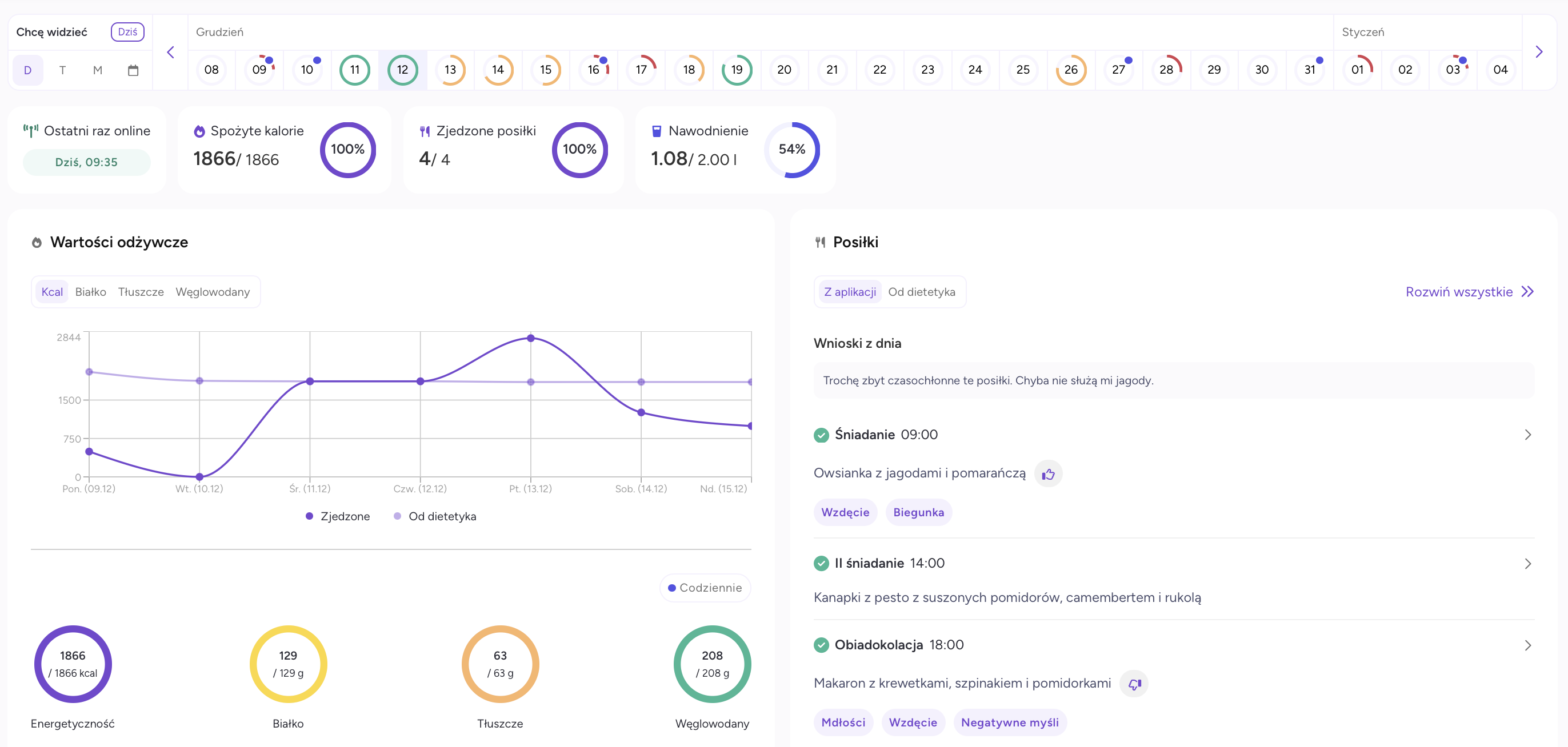
What is more, the module also allows you to analyze client’s body transformation over time based on their full measurement history, whether the data comes from completed questionnaires, entries made by dietitian during consultations or measurements added by client via mobile app. Progress can also be visually tracked through a dedicated photo gallery.
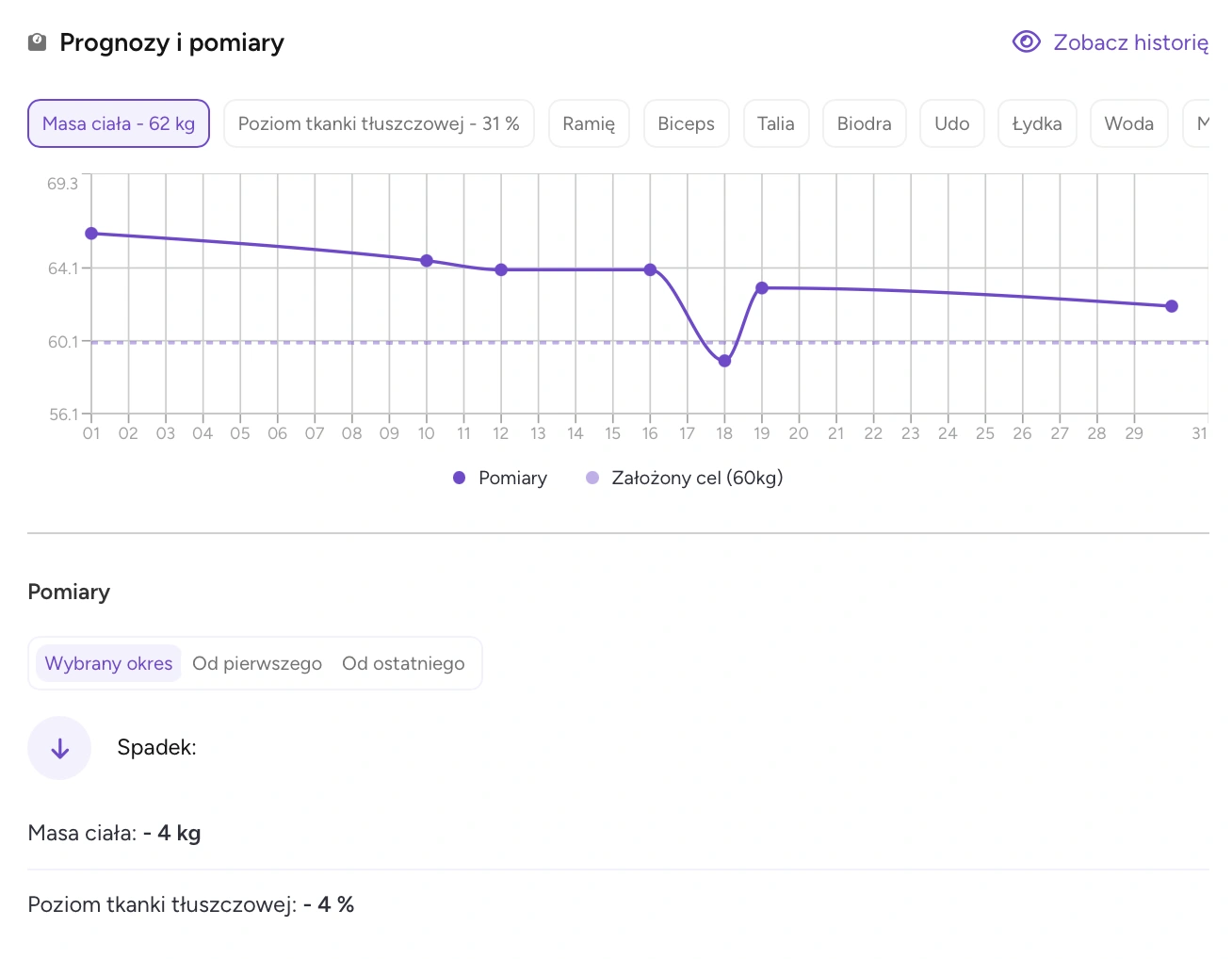
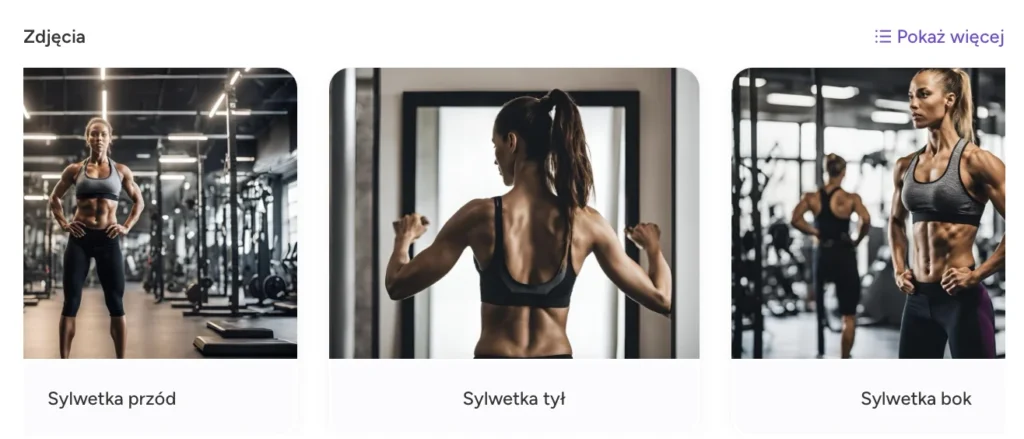
The module also allows you to track client’s hydration levels.
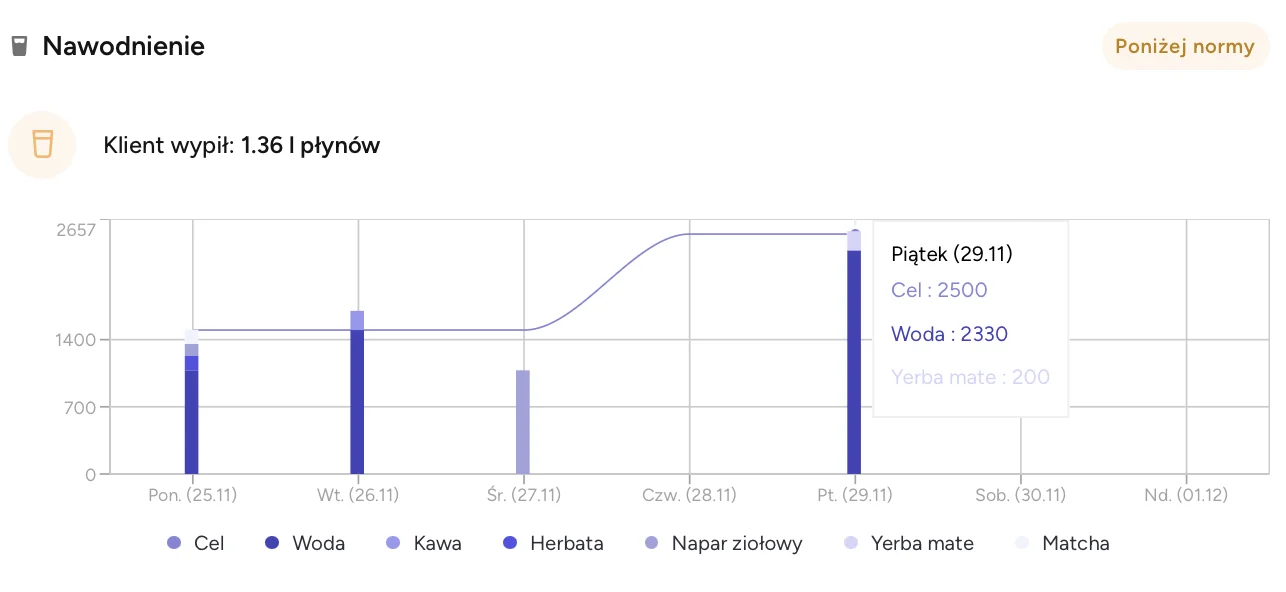
Most data is presented through clear, intuitive charts, so with just a quick glance, you can assess how your client is doing.
The Monitoring module helps you understand why client might be struggling to reach their goals and gives you full control over the follow-up process. It supports decision-making around the next steps in cooperation, your client education plan and interventions when difficulties arise.
WHAT IS THE DIFFERENCE?
The key difference between Dietetyk.pro and alloweat in tracking client progress lies in level of detail available for analysis. The “Monitoring” module in alloweat provides access to broad range of data, allowing you to gain comprehensive view of client’s situation. The ability to analyze collected information from different angles helps you better understand your client’s nutrition patterns, behavior trends and potential obstacles that may be hindering their progress. This insight allows you to provide regular, meaningful feedback that supports client in building independence and developing long-term healthy eating habits.
In contrast, Dietetyk.pro offers general analysis tools, mainly focused on summarizing measurements and checking whether client is following assigned meal plan. However, it does not allow for in-depth observation of client’s eating habits, especially if client prefers to modify meals or build their own. As a result, it is much harder to gain a realistic, day-to-day picture of how client actually eats.
Communication with client
Modern dietitian does more than just create personalized meal plans, they also support clients throughout the process of change, which often requires staying in regular contact. Ongoing communication helps build a deeper understanding of client’s expectations and needs, allows for quick responses when challenges arise and enables real-time adjustments to dietary recommendations as circumstances evolve. This approach significantly improves the overall effectiveness of cooperation.
DIETETYK. PRO
Platform allows you to stay in touch with your client through a built-in messaging module. To send a message, simply use the “Write a message” tab in client’s profile. All conversations are also visible from the main dashboard, making it easy to quickly access any ongoing chats. The chat module supports text-based communication and file attachments. However, voice messages are not currently supported.
ALLOWEAT
With alloweat, you can stay in touch with your client using the built-in chat system. In addition, there is a dedicated mobile app for dietitians that includes chat functionality. The chat module lets you send text messages, attach files and, unlike many other platforms, even exchange voice messages, making communication more personal and convenient.
WHAT IS THE DIFFERENCE?
Both platforms allow for regular interaction with clients through text messaging and file sharing within the system. Alloweat goes a step further by offering a dedicated chat app for dietitians and option to send voice messages, which can make communication more efficient and help save time.
Working with English-speaking client
Being able to support English-speaking clients opens the door to a wider audience and gives you a competitive edge by helping you stand out among other professionals.
DIETETYK.PRO
At this point, platform does not support working with English-speaking clients.
ALLOWEAT
With alloweat, you can easily work with English-speaking clients, whether you want to provide them with traditional PDF or share nutrition program via mobile app. Platform interface can also be switched to English, making the entire experience smooth and accessible for international clients.
WHAT IS THE DIFFERENCE?
Alloweat is the only solution on the market that offers full support for working with English-speaking clients.
Mobile app
DIETETYK.PRO
Dietetyk.pro mobile app allows clients to:
- view meal plan shared by their dietitian
- generate shopping list
- enter body measurements
- contact their dietitian
- book an appointment
When following meal plan created by dietitian, clients can mark whether or not they ate meals scheduled for a given day. The app also sends reminders 15 minutes before each planned meal. However, clients cannot modify meals or create their own. What they can do is log any deviations (as notes), record physical activity, track supplement intake and monitor hydration levels. They also have constant access to the recommendations prepared by their dietitian.
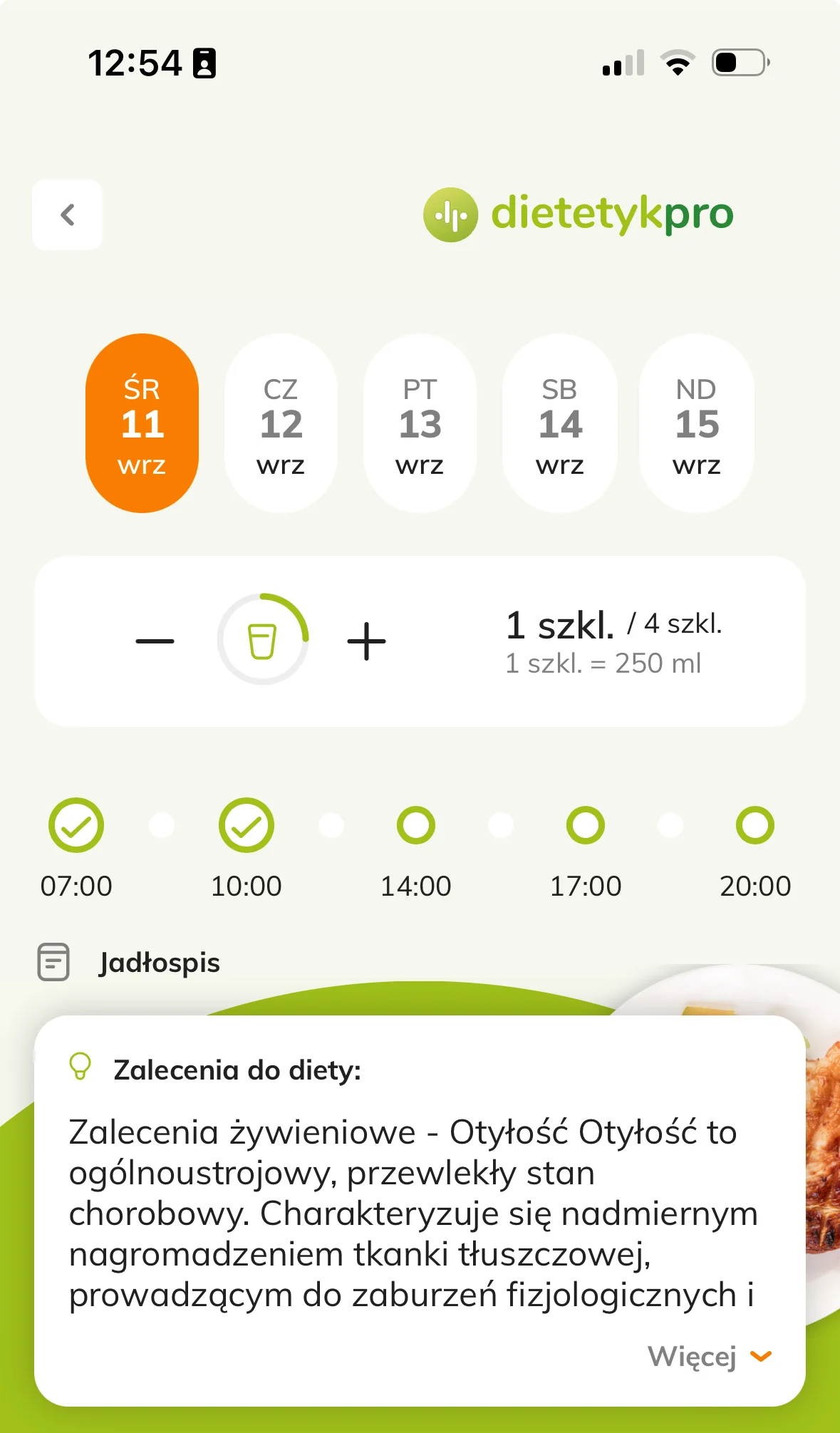

Clients can switch between multiple meal plans within the app. Each plan includes shopping list that can be generated either for the entire duration of the plan or for specific days.

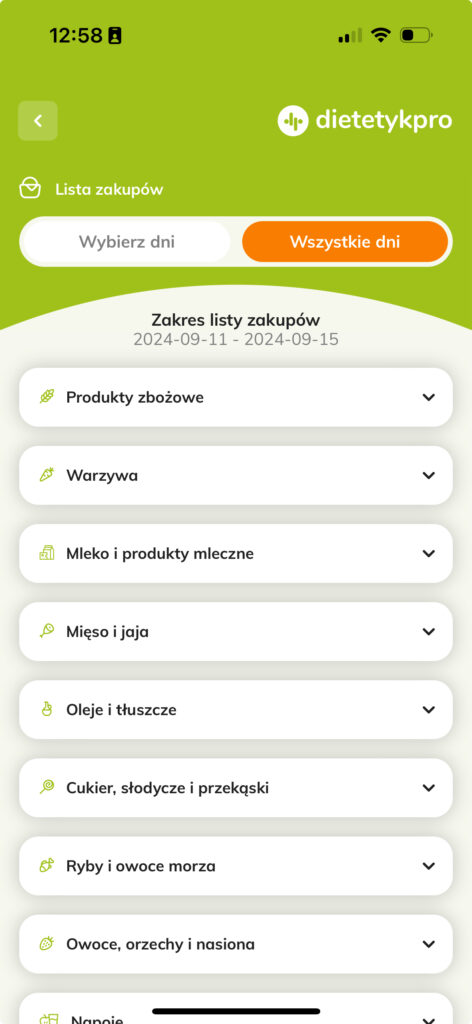
Additionally, clients can enter their own measurements, such as body weight and circumferences and track their progress using clear, easy-to-read charts.
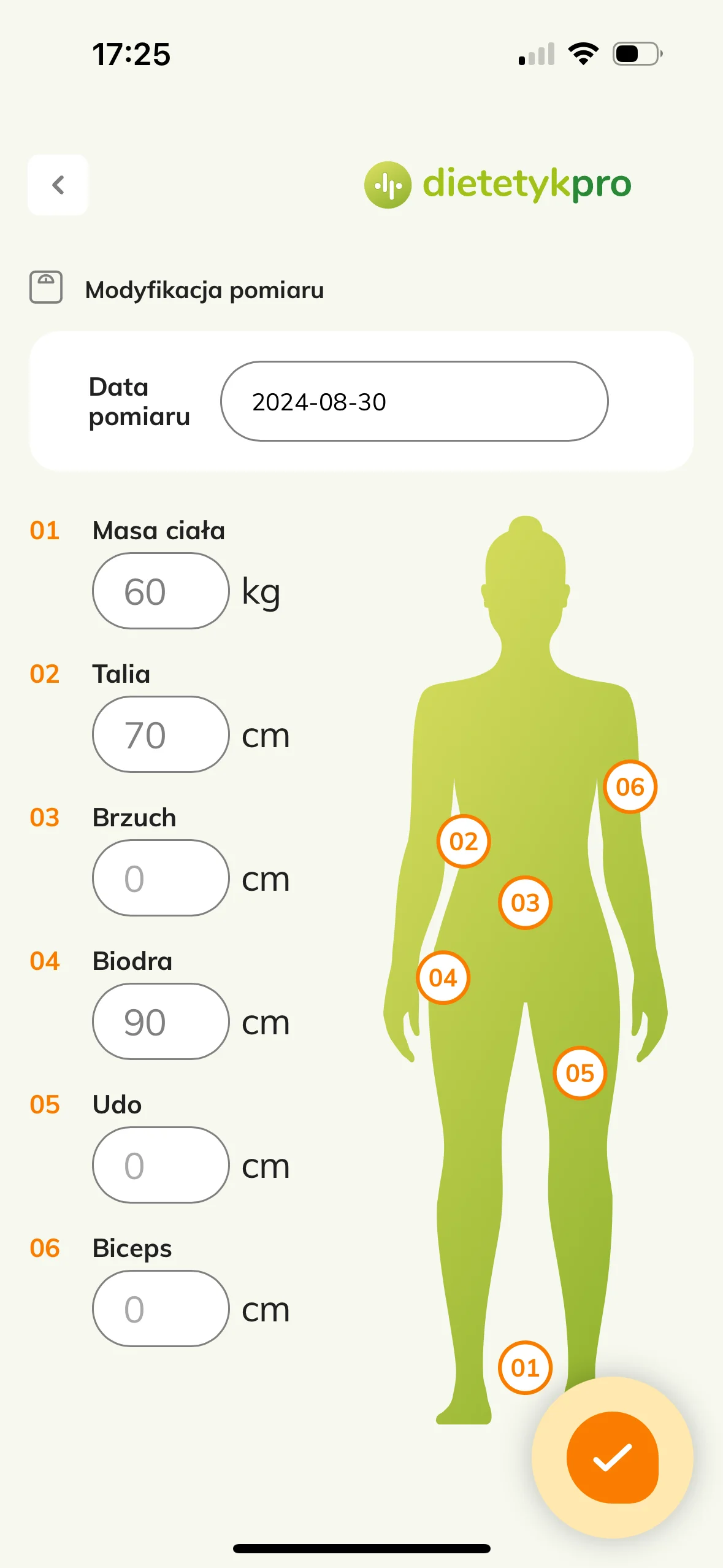
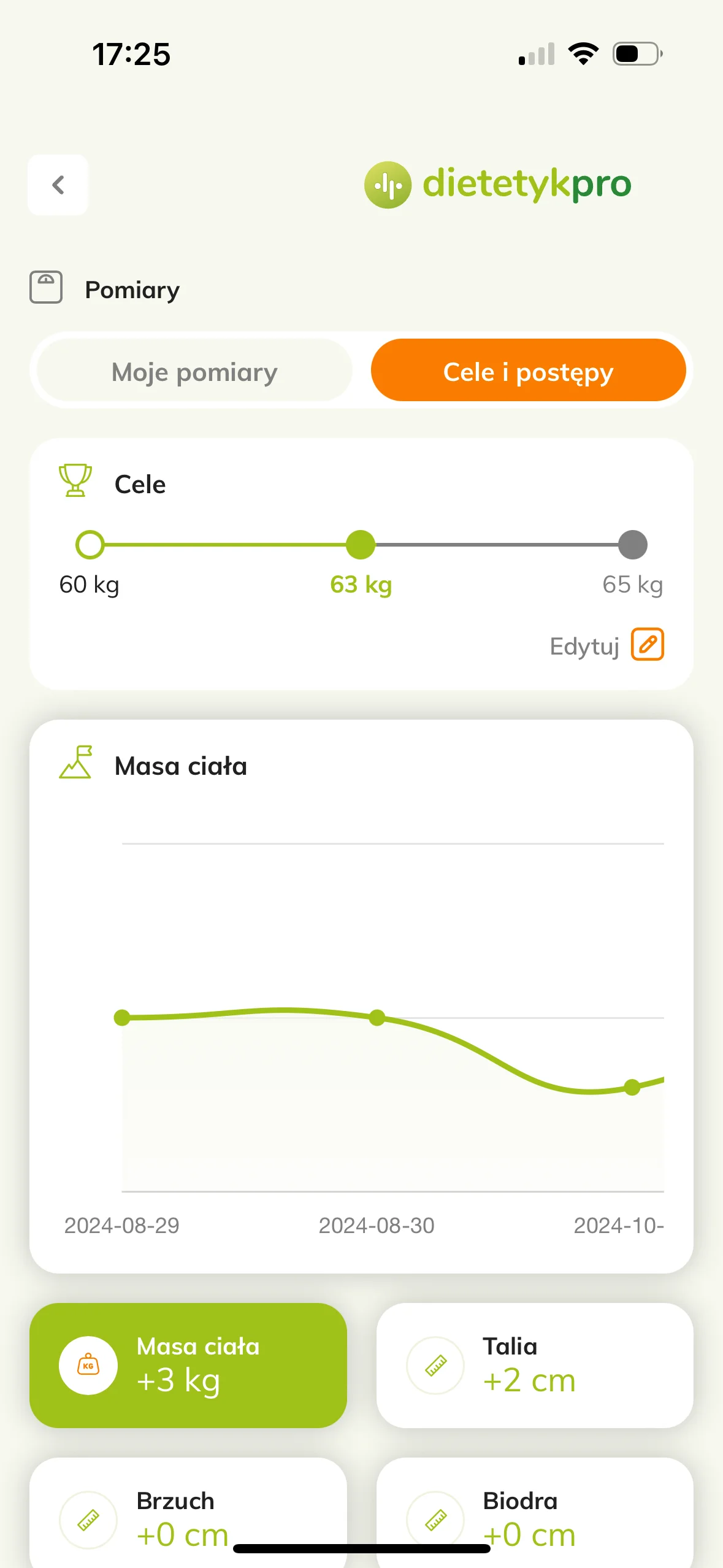
The “Messages” module allows clients to stay in direct contact with their dietitian.
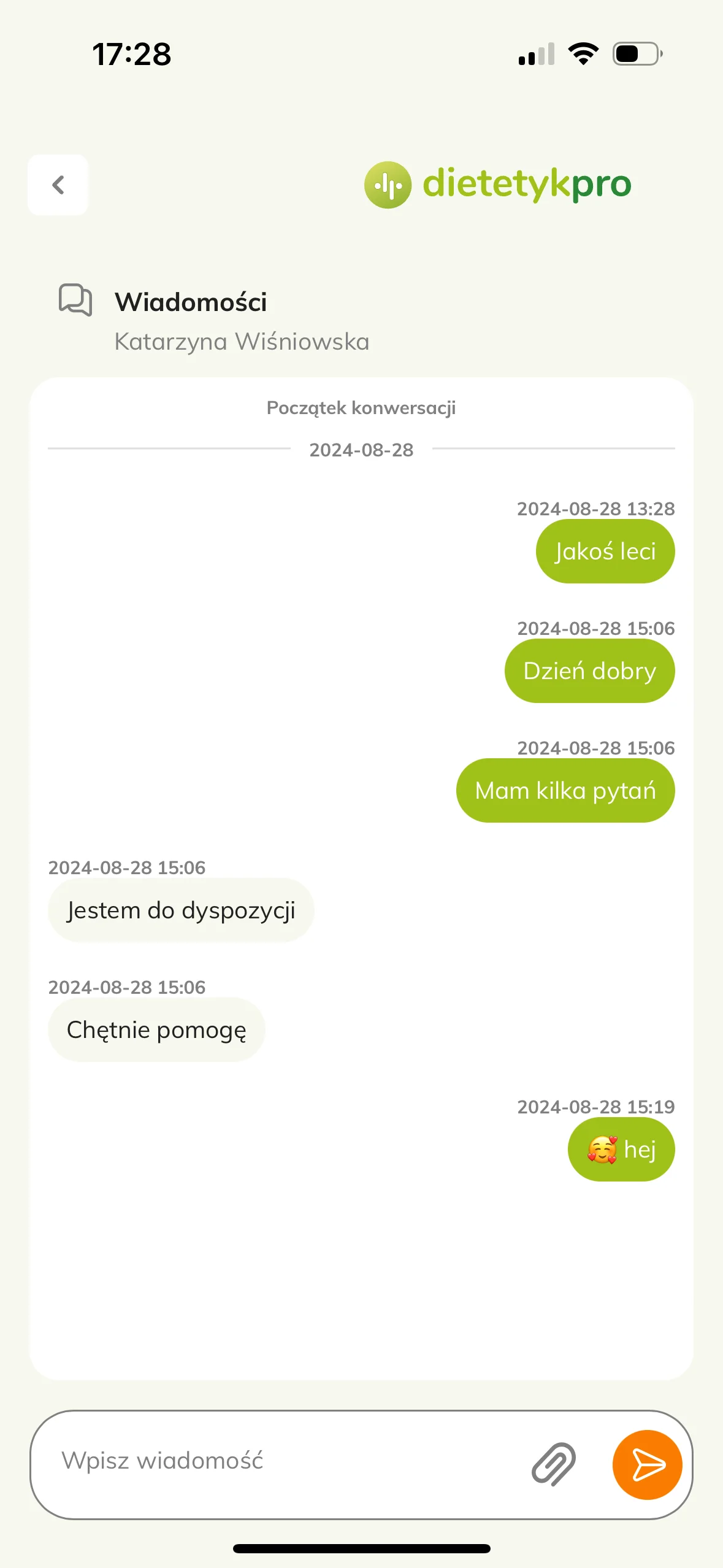
One particularly useful feature is the ability for clients to book or cancel appointments directly through the app, thanks to the integration between Dietetyk.pro and the DietDoctor calendar.
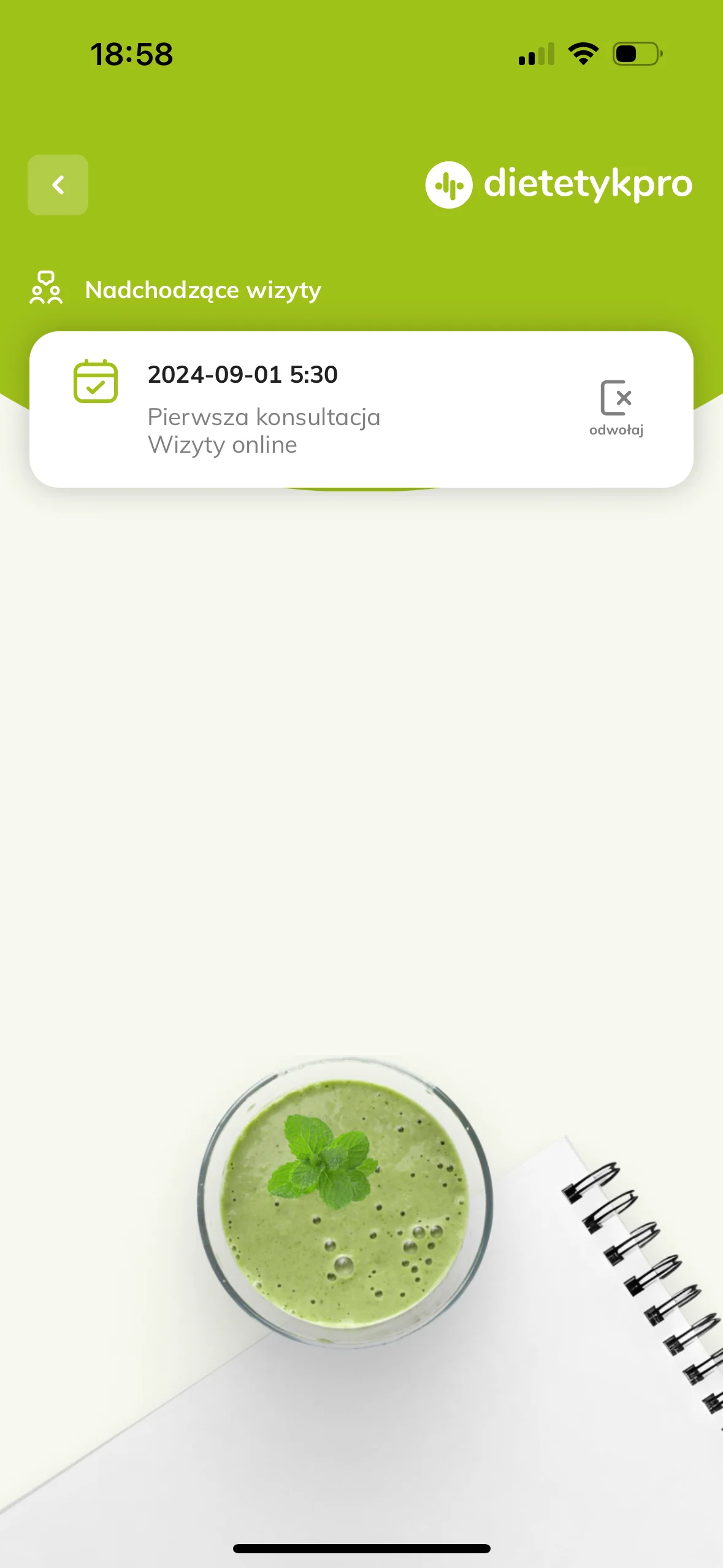
ALLOWEAT
The alloweat app is designed with both clients and dietitians in mind. Thanks to its thoughtful features, the app helps users stay on top of their daily nutrition habits and work toward their goals, while also reducing workload for dietitians.
For client, the app acts as a nutrition companion, helping them stay organized with meal planning and grocery shopping. There are two ways to use the app: by following recipes shared by dietitian as part of a personalized nutrition program or by creating meals independently based on the recommended calorie target and macronutrient breakdown. Regardless of the chosen approach, the app gives client a high degree of flexibility. They can freely swap or edit meals to match their taste preferences, available ingredients or time constraints. By giving clients more autonomy, dietitian can shift focus to more strategic aspects of the cooperation, such as monitoring progress and responding quickly to changing needs.
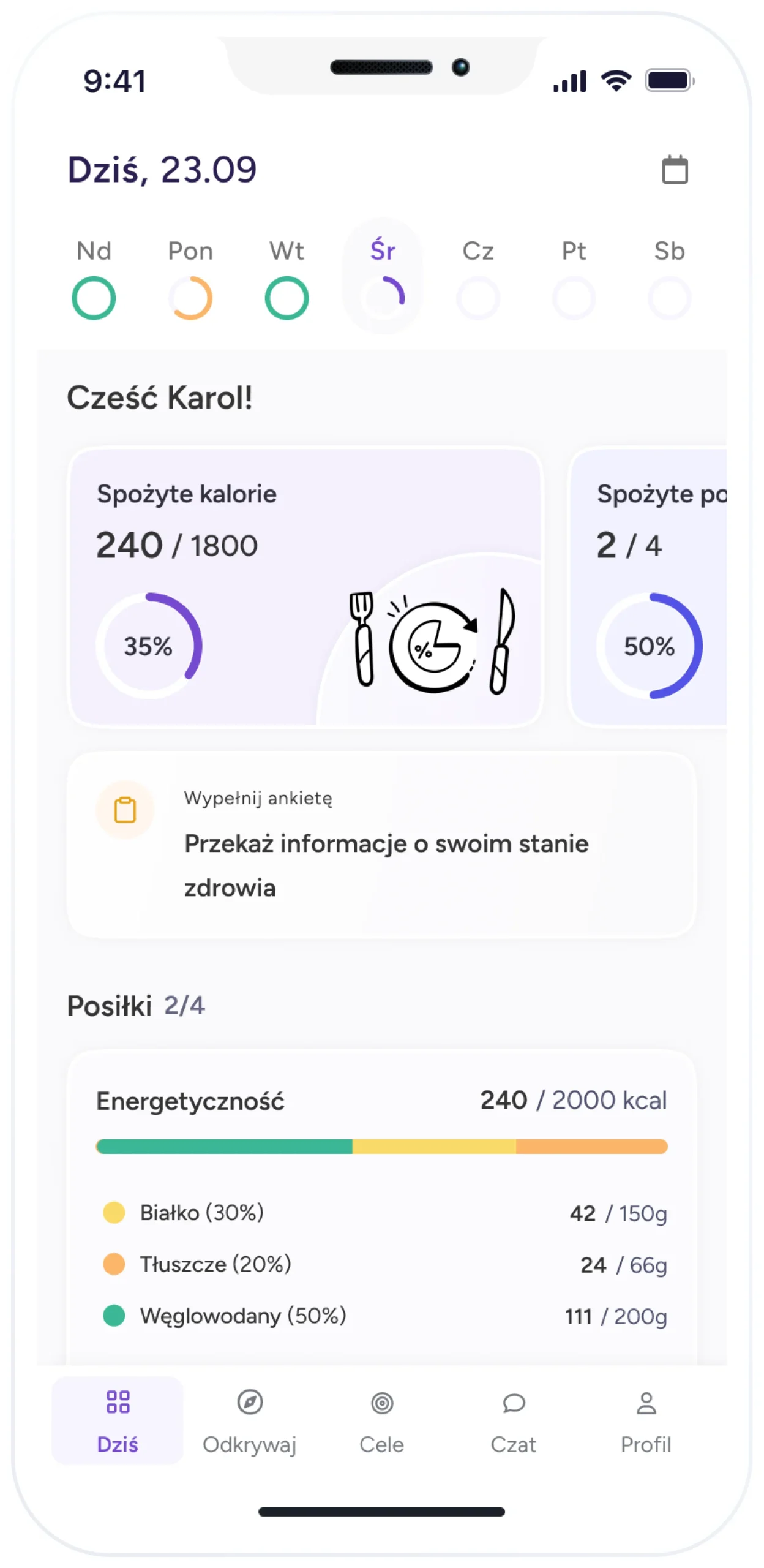
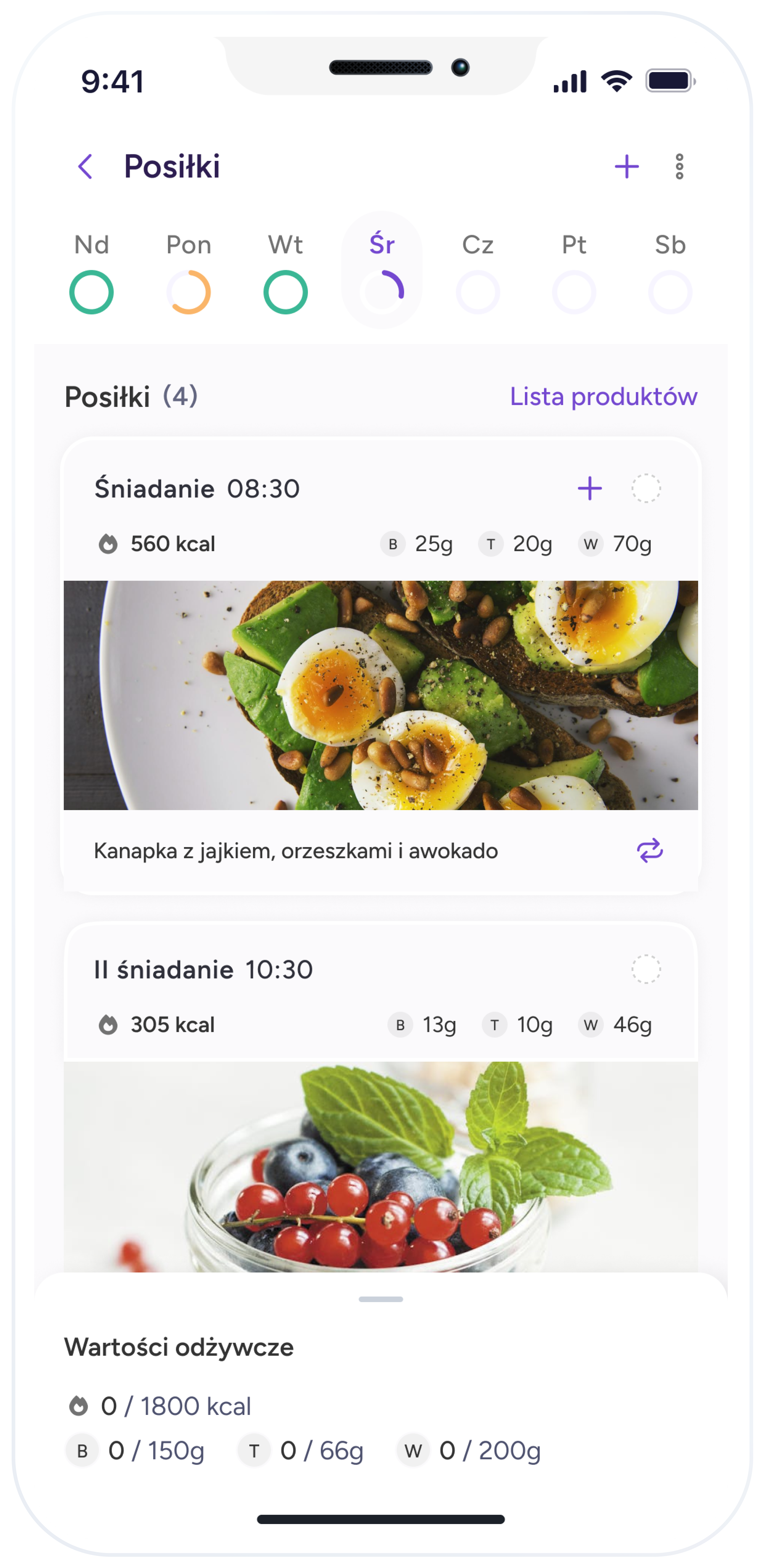
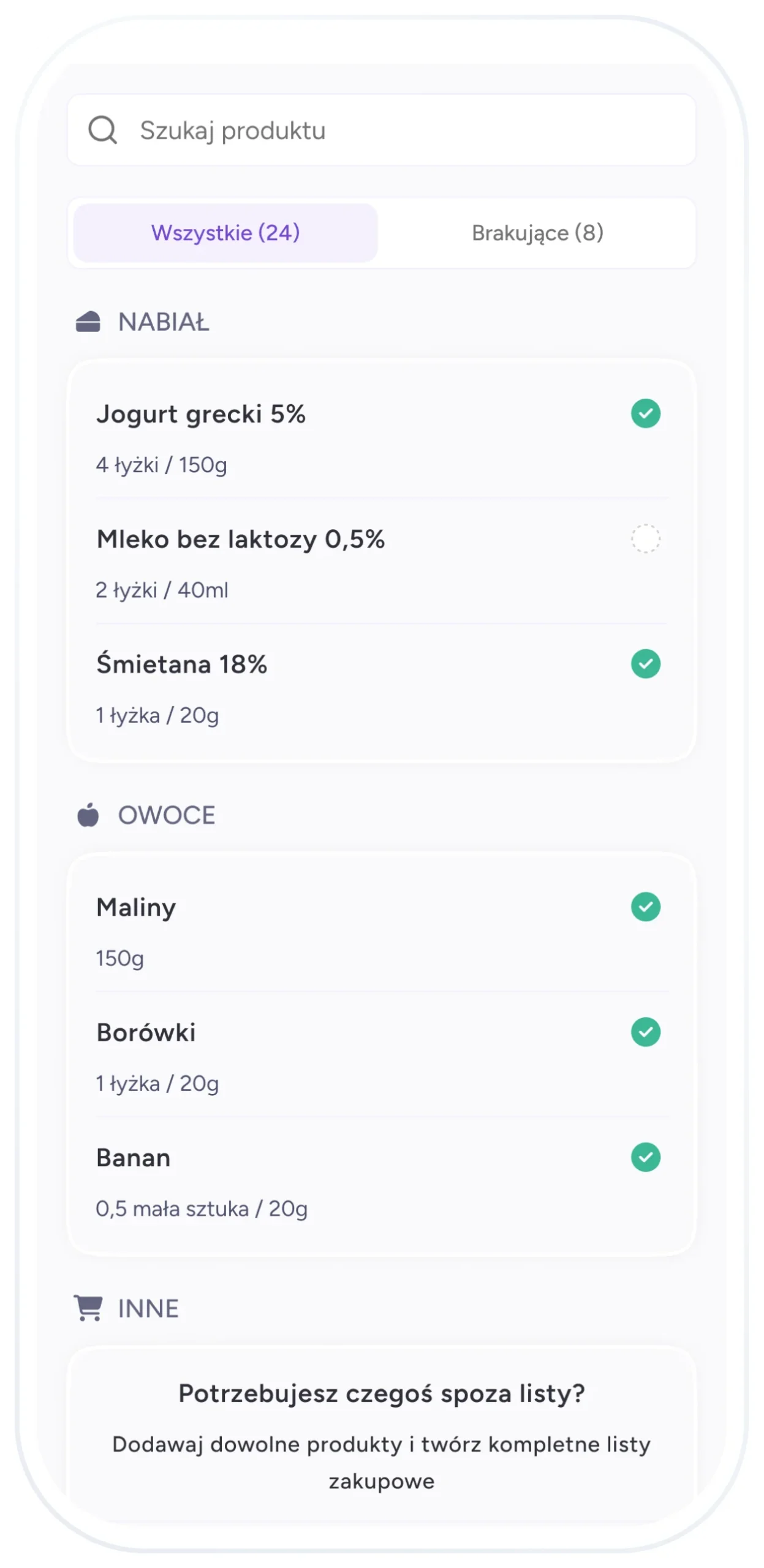
The alloweat app also helps engage clients in the process by allowing them to rate meals based on taste and note any symptoms or changes in how they feel.
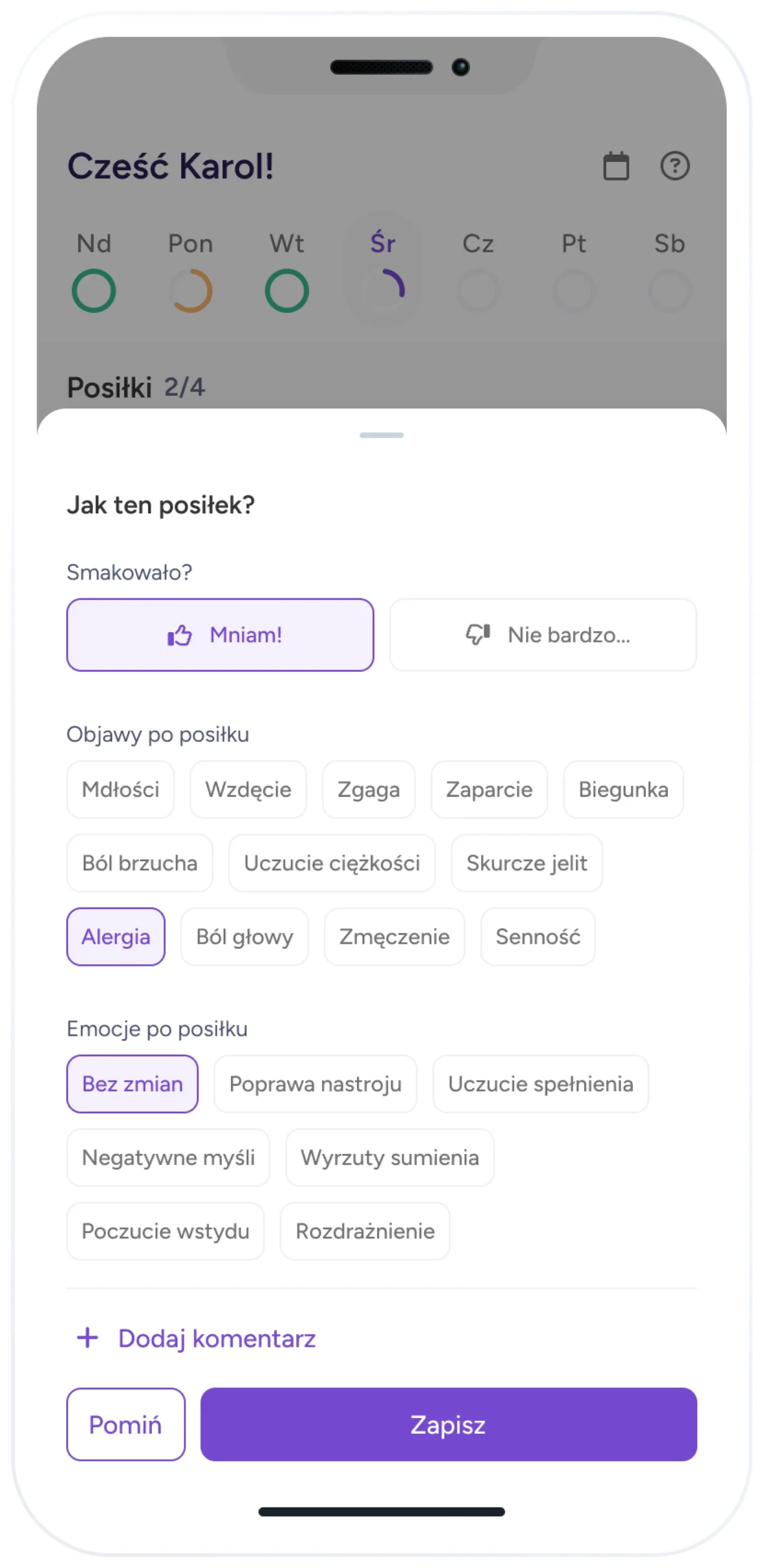
Clients can communicate in two ways: asynchronously – by leaving comments on meals or sharing reflections at the end of the day or directly – through the built-in chat. This gives dietitians real-time insights into how client is feeling, while client feels supported and reassured that their progress is being actively monitored.
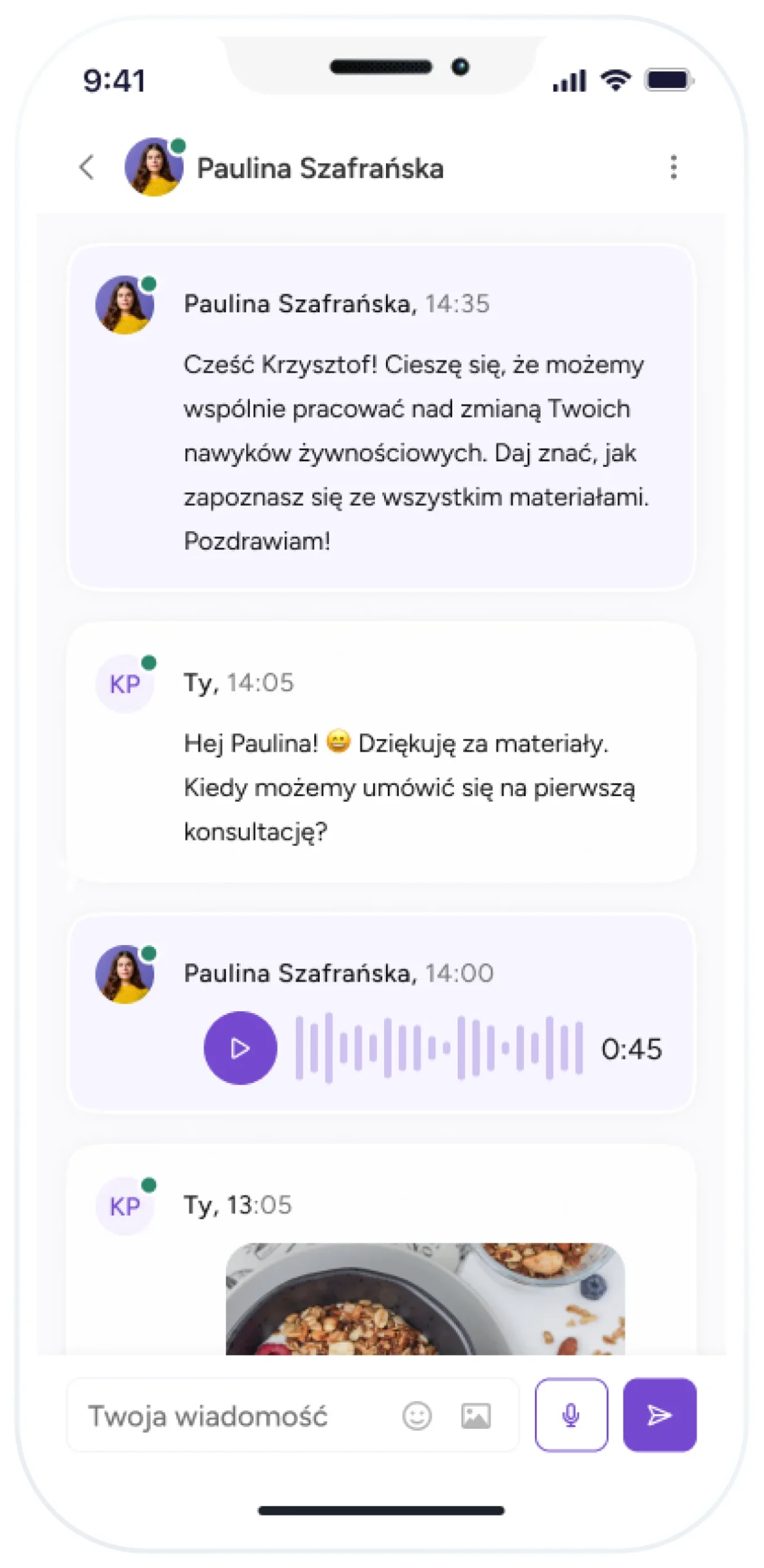
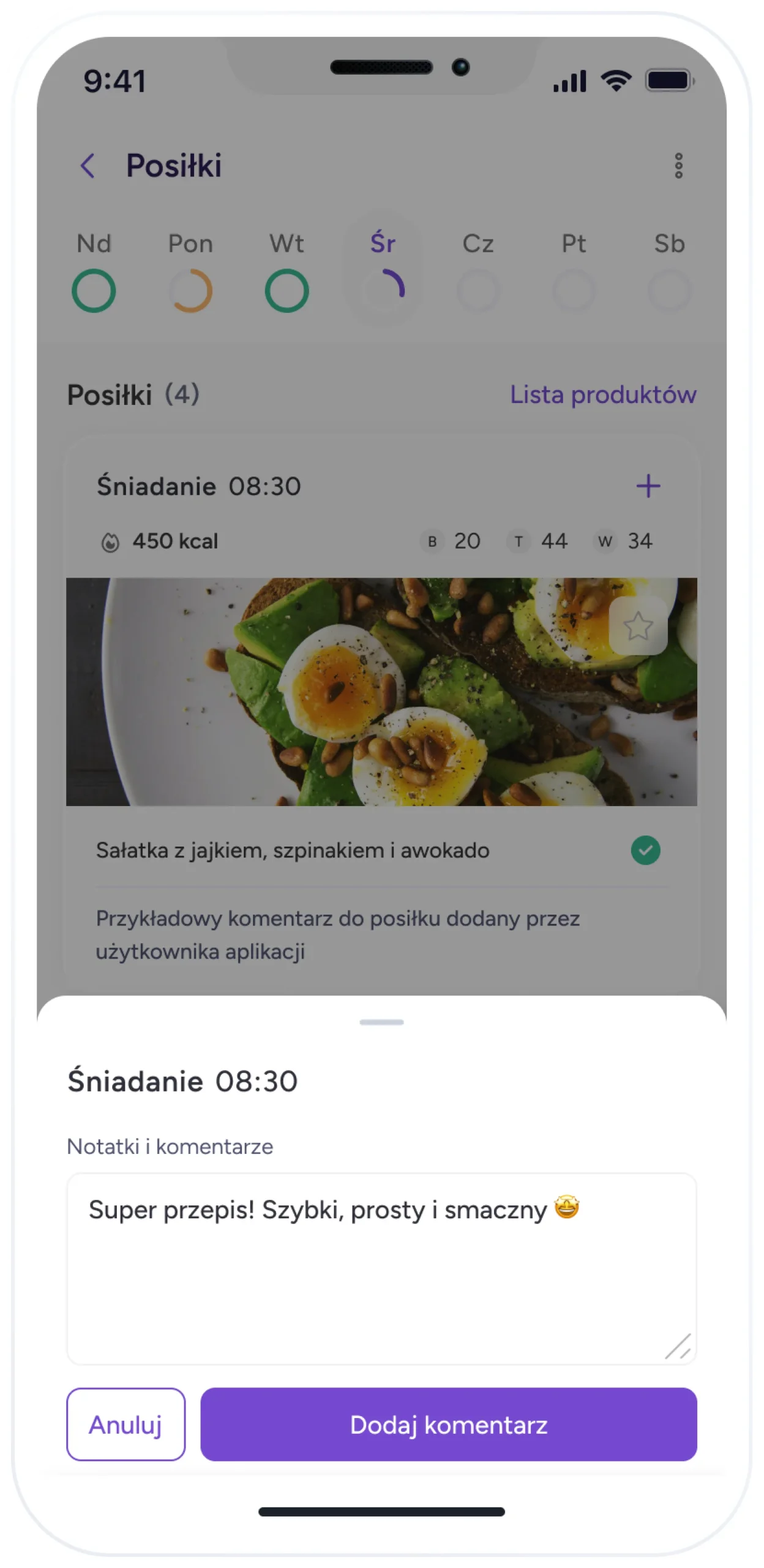
The app also includes access to educational resources shared by dietitian. Clients can track their intake of specific nutrients relevant to their health goals, making education an integral part of cooperation. Learning journey can easily be tailored to the client’s knowledge level and nutritional awareness.
On top of that, the app serves as a source of daily inspiration. Clients can access a general database of over 6,500 recipes (if enabled by dietitian), with advanced filtering options. In the “Discover” tab, they will find new recipe suggestions each week, tailored to their preferences.
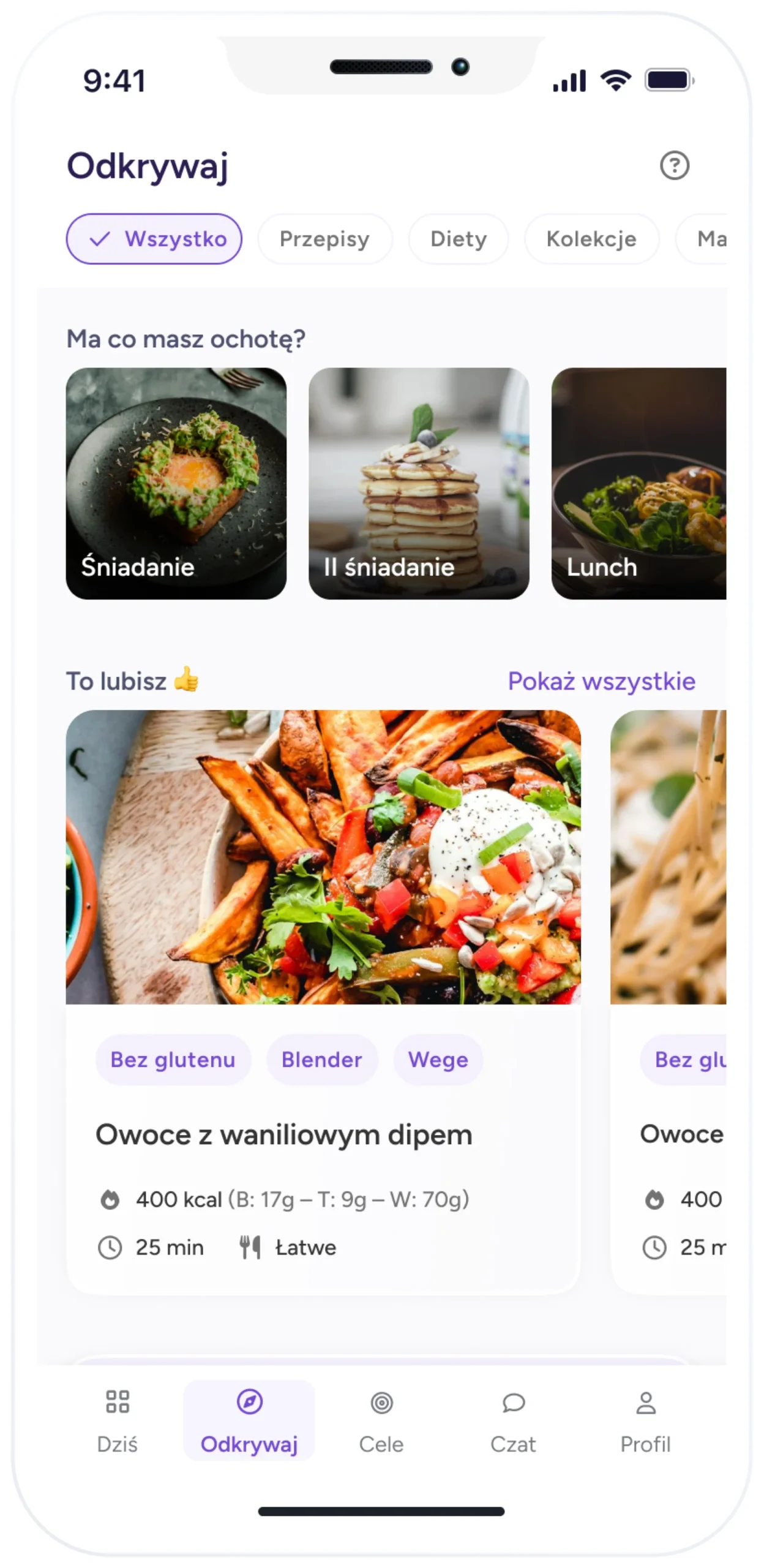
In the “Goals” section, clients can also track progress related to their body composition and hydration. This gives them full control over their actions and helps them stay focused and intentional in working toward their goals.
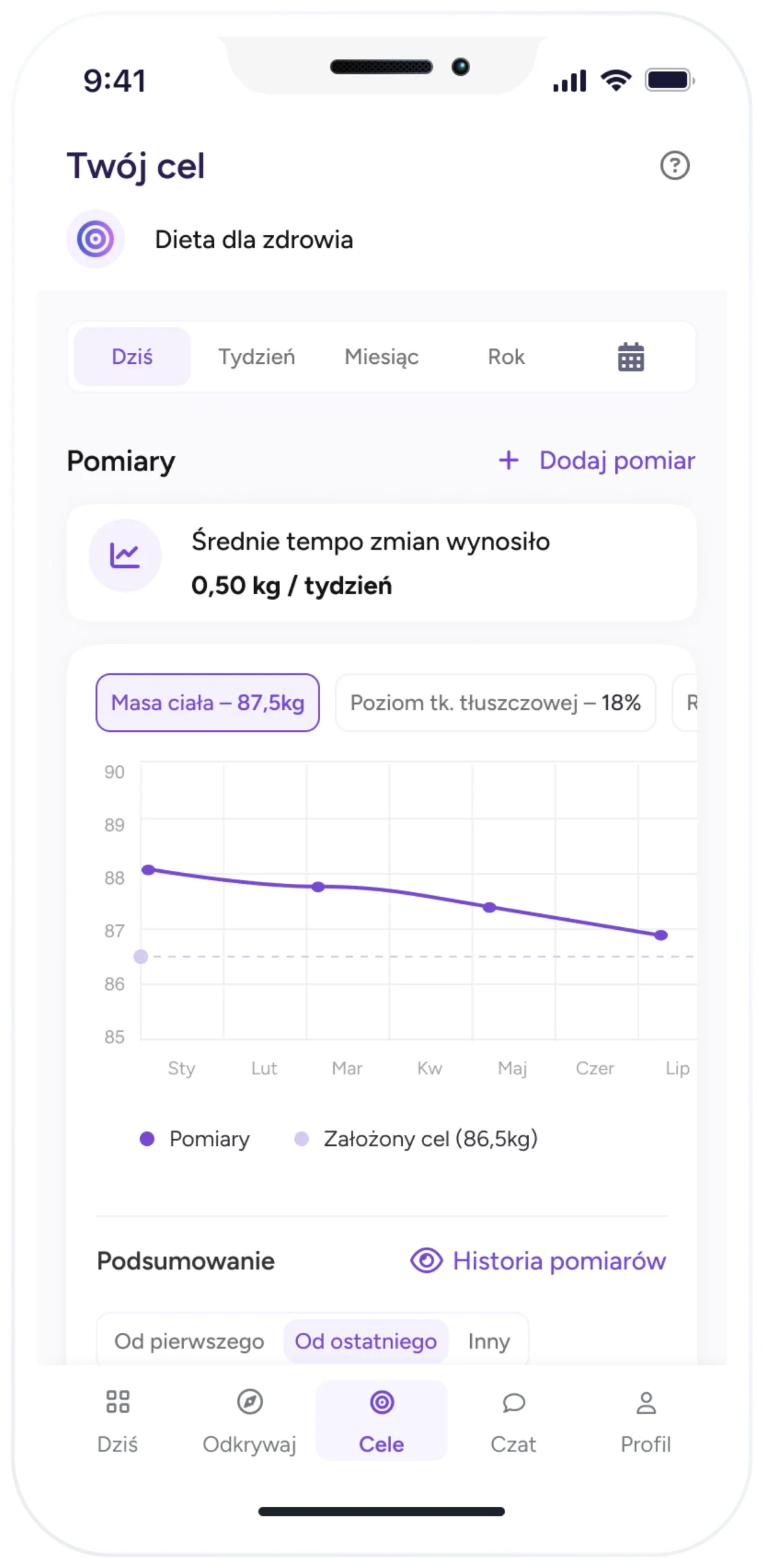
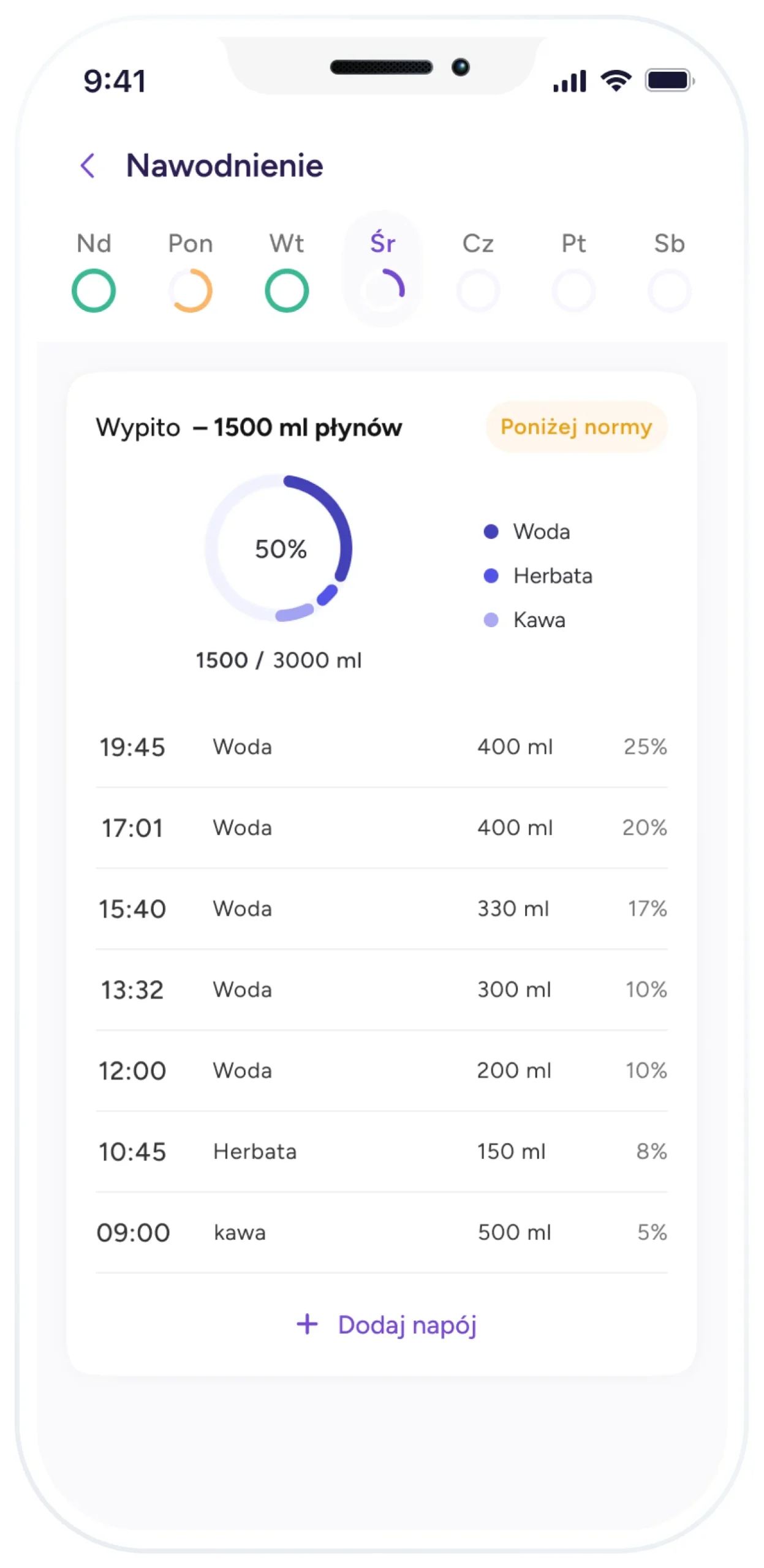
Importantly, alloweat is not only a powerful tool for supporting clients, it also opens up opportunities for generating passive income for dietitians. Beyond one-on-one client cooperation, you can for example, sell interactive e-books bundled with app access on a subscription basis.
WHAT IS THE DIFFERENCE?
The alloweat app is redefining how dietitians and clients work together, offering a comprehensive set of features that go far beyond simply viewing meal plan. It is a tool designed to adapt the cooperation to each client’s individual needs, supporting them at every stage: from meal planning and goal tracking to maintaining long-term results.
With the ability to modify meals, swap ingredients and explore vast recipe database, the app empowers clients to make daily food choices that align with their goals, while also sparking curiosity and reflection. This encourages clients to build a personalized approach to eating that feels sustainable and comfortable. Progress tracking helps them understand how the process is evolving and where adjustments can be made for even better outcomes.
For dietitians, alloweat also delivers added value through the opportunity to build a reliable stream of recurring income. Whether it is through ongoing client cooperations or offering interactive e-books with app access on a subscription basis, platform supports both client transformation and business growth. So, if you are looking to give your clients a personal assistant for changing their eating habits and equip yourself with a tool that strengthens your financial stability – alloweat is built to meet those needs.
Available packages and pricing
DIETETYK.PRO
After the trial period ends, Dietetyk.pro offers two subscription plans:
- Standard
- Premium Pro (equivalent to the trial version, with access to all features)
The Standard plan limits access to several important features, such as global ingredient replacement, nutrition interview and recommendation editors, tools that significantly impact the quality of service and workflow efficiency.
Each subscription plan can be purchased for a month, 6 months or a full year, with the following pricing (excluding VAT):
| Subscription period | Standard plan | Premium Pro plan |
| 1 month | 47zl net | 85zl net |
| 6 months | 226,02zl net | 319,20zl net |
| 12 months | 324,39zl net | 520zl net |
Dietetyk.pro also offers special discounts for students and group pricing option.
ALLOWEAT
After the trial period, alloweat offers two main subscription plans:
| Subscription period | Starter plan | Scale 100 plan |
| 1 month | 129zl net | 199zl net |
| 12 months | 1164zl net | 2004zl net |
The Starter package is a great option for dietitians who are just beginning their professional journey, want to embrace modern tools and are still building their client base.
The Scale package is ideal for professionals looking to automate more of their workflow and scale their business efficiently.
Each plan includes different set of features, making it easy to choose the right one based on your needs. By choosing the annual plan, you can save up to 25% compared to the monthly subscription.
Students are eligible for a 50% discount on any annual plan.
Summary
Comparison between Dietetyk.pro and alloweat shows that both platforms offer variety of useful tools to support dietitians in their daily work. However, they differ significantly in their approach to client cooperation, functionality of their mobile apps and pricing.
Dietetyk.pro is a solution focused on precise meal planning and traditional client work, giving dietitians full control over every aspect of the process. Thanks to its integration with the external DietDoctor calendar, managing appointments is simple and the mobile app allows clients to view meal plans, enter measurements and get in touch with their dietitian. This makes Dietetyk.pro a good fit for professionals who prefer a more classic, structured workflow.
In terms of pricing, Dietetyk.pro is a budget-friendly solution, ideal for those who need essential tools at a lower cost.
Alloweat, on the other hand, offers modern and flexible approach to working with clients. Its mobile app allows for greater interactivity and gives clients more freedom in shaping their eating habits. Platform also includes an advanced monitoring module that enables a deeper analysis of client behaviors and progress. On top of that, alloweat supports dietitians in generating passive income.
From a pricing perspective, alloweat offers a flexible model tailored to the scale of your business. While the upfront cost may appear higher, investment can quickly pay off, thanks to automation and the ability to serve more clients efficiently. Plus, it creates opportunities to diversify your income using the mobile app’s full potential (e.g., selling interactive e-books with app access).
In summary, the choice between Dietetyk.pro and alloweat depends on your individual needs.
Dietetyk.pro is a good fit for those who prefer traditional methods of working and are looking for a more budget-friendly solution. In contrast, alloweat is an excellent choice for professionals open to modern technology, those who want to focus on building strong client relationships and are looking for a comprehensive tool to support the growth of their dietetic practice.






